

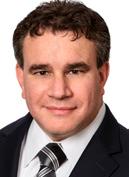





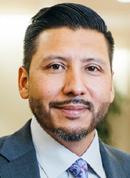


















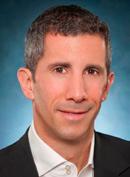


















































Nicole Rodriguez
Sr. Director, People Strategy Lead, S&P Global
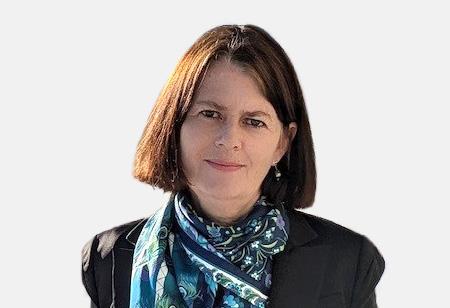
Marcela Mikkola Senior Data Researcher, S&P Global Ratings
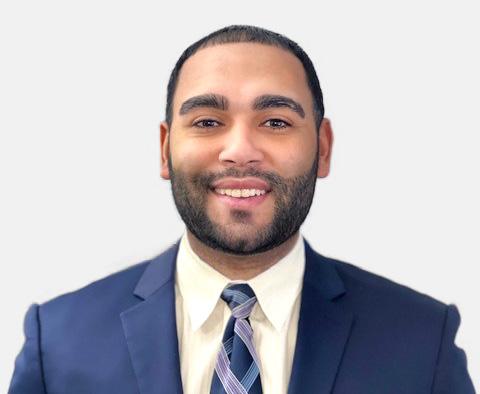
Michael Bonilla
Sr. Corporate Strategy Analyst, S&P Global

Paula Rojnica
Sr. Director, Data Operations, S&P Global Market Intelligence
S&P Global is proud to congratulate our four outstanding colleagues who have been recognized as Latino Leaders Worth Watching™. Through their talent, skills and dedication to excellence, they help us power the markets of the future and accelerate progress in the world.

All Things Diversity & Inclusion
FOUNDER/CEO/PUBLISHER
James R. Rector
VICE PRESIDENT OF OPERATIONS
James Gorman
DESIGNER
Stephen A. Toth
ASSOCIATE EDITOR
Teresa Fausey
EXECUTIVE ASSISTANT
Elena Rector
WEBMASTER
David Toth
LETTERS TO THE EDITOR
Profiles in Diversity Journal
Gemini Towers #1 • 1991 Crocker Road, Suite 600 • Westlake, OH 44145
Tel: 440.892.0444 • Fax: 440.892.0737 profiles@diversityjournal.com
SUBSCRIPTIONS
Single issue $14.95
1 year subscription (4 issues) $45.00
2 year subscription (8 issues) $82.50
Canada, 1 year subscription $52.50 Canada, 2 year subscription $97.50 International, 1 year $99.95 International, 2 year $187.50
U.S. funds only. Subscriptions can be ordered at: www.diversityjournal.com or call customer service at 800.573.2867
Copyright © 2021 Rector Inc.
SUBMISSIONS
REPRINTS: profiles@diversityjournal.com
EDITORIAL: profiles@diversityjournal.com
PHOTOS & ARTWORK: art@diversityjournal.com
FOLLOW US AT: issuu.com/diversityjournal
Profiles in Diversity Journal® is a quarterly magazine dedicated to promoting and advancing diversity and inclusion in the corporate, government, nonprofit, higher education, and military sectors. For more than 23 years, we have helped to stimulate organizational change by showcasing the visionary leadership, innovative programs, and committed individuals that are making it happen.
The views expressed in this publication are those of the authors and may or may not represent the views of the publisher. Reproduction in whole or in part without written permission is prohibited. Registered in U.S. Patent Office

Congratulations to all the individuals and organizations that appear in this winter issue. We, as a team, are honored to present 49 winners of PDJ’s leadership and achievement awards for Latino Leaders and Diversity Leaders. What makes this effort rewarding is that these names are not pulled out of a hat. These individuals are selected carefully by their employers or peers who go through a nomination process.
Once the awardees are selected, they each provide a personal essay about their careers and their perspectives on issues of personal interest. Many of these essays are of a mentoring nature and therefore offer valuable guidance to other professionals at all career levels.
For 2021, our primary focus continues to be working with organizations to highlight and acknowledge worthy candidates for their leadership and achievement. If you visit our website, www.diversityjournal.com, and click on the Awards tab, you will see that we continue to make a strong effort to become increasingly inclusive with our awards.
For example, the 2020-21 winter issue includes our longstanding Diversity Leader Award, as well as a new award: Latino Leaders Worth Watching. The 2021 spring issue will include Women Worth Watching in STEM and a new award: Asian Leaders Worth Watching. And the summer issue will feature our 20th Annual Women Worth Watching® in Leadership Award, along with a new award: Indigenous Leaders Worth Watching.
The individuals profiled in this issue, and in all of our issues, are genuine and worthy of recognition. Our process for identifying current and future leaders is unique in that each profile offers the reader insight into the origins and workings of leadership. Each profile represents a giving back and paying it forward approach. Each award winner is an asset to his or her respective employer and to our nation.
We are grateful to all the organizations that participate in these personalized awards, and we look forward to sharing many more stimulating profiles in future issues.
James R. Rector Publisher & Founder
Since 1999




Leaders Worth Watching
We are pleased and proud to introduce PDJ’s inaugural class of Latino Leaders Worth Watching Award recipients. They are extraordinary individuals who have blazed new trails, mentored the next generation, and advanced the cause of diversity and inclusion. Get to know them and join us in celebrating their achievements.












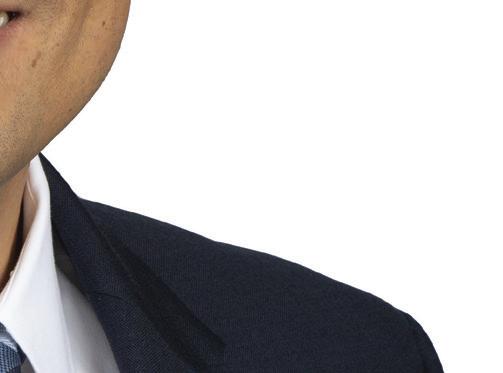
We proudly congratulate our own Eliecer Viamontes, Entergy vice president of utility distribution operations, for being selected as one of Diversity Journal’s 2021 Latino Leaders Worth Watching. Eli is a great asset to our company and a leader dedicated to diversity and inclusion.
We thank Eli for his continued dedication to excellence and congratulate the other individuals recognized. Together, we power life with a diverse, inclusive and engaged culture that inspires all individuals to work together to grow a world-class energy business that creates sustainable value.


PAGE 10
In this follow-up article to Four Essential Levers CEOs Can Adopt to Achieve Racial and Gender Equality, which appeared in the fall 2020 issue of PDJ, author Donald Fan shares with readers how leaders at Walmart have successfully employed the four levers to make great strides toward achieving their equality goals.


PAGE 14
The author offers women determined to build successful careers five great tips that will help them do just that. She says to ask questions, find a mentor, build your network, learn to read the room, and share, share, share with other women.

Dechert is a global law firm that achieves dynamic results by embracing diversity and innovation. We are proud of our recent achievements – and eager for the continuing growth and progress the future will bring.
• Perfect score in the corporate equity index (CEI) and named one of the best places to work for LGBTQ equality Human Rights Campaign, 2021
• Diversity Leader Award, Diversity Team Award and Innovations in Diversity Award. Profiles in Diversity Journal, 2020
• Top Companies for Executive Women. National Association for Female Executives, 2020
• One of the Best Law Firms for Women and Top 100 Companies for Women. Working Mother, 2020
• Most Outstanding Firm for Diversity and Inclusion. Chambers Europe, 2019 dechect.com/diversity

DDiversity and Inclusion

“If you aim to be something you are not, you will always fail. Aim to be you. Aim to look and act and think like you. Aim to be the truest version of you. Embrace that you-ness. Endorse it. Love it. Work hard at it. And don't give a second thought when people mock it or ridicule it. Most gossip is envy in disguise.”
– Matt Haig, The Midnight Library
I was all set to write this column about spring—about newness and hope and growth and renewal. But then I happened upon the above quote and changed my mind. Spring, and the new opportunities, the new life, it represents is a wonderful thing, but I recognized our award winners, our contributors, and our readers in the quote and decided to write about them.
For most of us, being completely ourselves is probably the most difficult thing we try to do. It sometimes seems as if family, friends, teachers, bosses, advertisers, career advisors, and even complete strangers want to tell us who and what we should be, how we should present ourselves, and why who we actually are isn’t a “good fit.”
But the people who appear in the pages of our magazine have ignored those people. They are unapologetically themselves. They have followed their own instincts and often, created their own career path. And, they have been willing to change course when it became clear that their current course wasn’t a good fit for them.
Owning who they are and what they think and how they interact with others is an admirable trait that nearly every contributor and every award winner that we at PDJ encounter seems to have been born with or worked to acquire. Again and again, I read contributors’ articles and nominees’ essays that, in one way or another, deliver the author’s authentic self, talk about their successes and failures, their passions and their fears, and share their life experiences—honestly and unvarnished.
That’s what makes them leaders and winners—and what makes their stories important and inspiring.
Just to give spring its due, I want to include this quote from Edith Mary Pargeter, a British writer who, ironically, authored many books under the pen name, Ellis Peters:
“Every spring is the only spring, a perpetual astonishment.”
Thanks for reading.
Teresa Fausey Associate Editor


In this article, the writer discusses the importance of expanding your talent network in order to recruit more diverse talent and taking steps to keep the diverse talent you have by supporting your diverse employees.
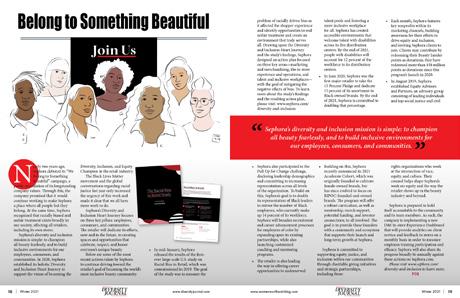

Sephora shares a case study of its “We Belong to Something Beautiful” campaign, which was part of an effort to “make Sephora a place where all people feel they belong.” Read about the strategies company leaders put in place, the steps they took, the results they realized, and where they go from here.
Authors Janet Crenshaw Smith and Gary A. Smith, Jr. discuss the power we all have to say something when you see something, to take care of yourself, to make referrals, and to give and receive valuable feedback—and how using your power can help transform your career and your workplace.

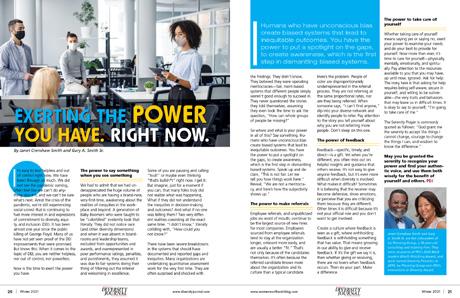
Author Michael Brugeja shares with readers the importance of understanding the human experience of racism. He reaches beyond an “academic” discussion of diversity, inclusion, and equity to explore how individuals experience racism and how biases color what we do.

Although the ADA has made inroads for people with physical disabilities—requiring employers to provide access and accommodation, many people who have what the author refers to as “invisible” disabilities are not offered the same consideration. Her own experience, as a person with a severe stutter, has been that employers often ignore her credentials and instead assume that she is an individual of “low intelligence.”


Profiles in Diversity Journal invites you to get to know the extraordinary organizations and individuals who have been named this year’s Diversity Leaders. In their profiles, you will find ideas and strategies you can use to help move your own organization toward your diversity, inclusion, and equity goals. And we know you’ll be inspired by their insights, enthusiasm, and inspiring personal stories.

Catch up with a dozen past Women Worth Watching Award recipients and find out what they’ve been up to professionally. Whether they have moved up the career ladder, joined a new team, or struck out on their own, their contributions and achievements continue to impress and inspire.


Do you have in your organization?

Long before they became CEOs, we knew that these were Women





Ursula
Marillyn
Michele
Ilene
Karen








The following article was written as a follow-up to an article by the same author that appeared in the fall 2020 issue of PDJ. To read the original article, entitled “Four Essential Levers CEOs Can Adopt to Achieve Racial and Gender Equality,” go to the PDJ homepage (diversityjournal.com) and click on Fall 2020—Diversity Journal
By Donald Fan, Senior Director, Global Office of Culture, Diversity, Equity & Inclusion for Walmart
More and more organizations have recognized the significance of advancing equity as a strategic imperative and competitive advantage. In my article, which appeared in the fall issue of this publication and was entitled “Four Essential Levers CEOs Can Adopt to Achieve Racial and Gender Equality,” I discussed how the following four essential factors play an integral role in cultivating an equitable and inclusive culture: leading purposefully; making a cultural change; fostering an ecosystem; and focusing on actions and changes. In order to spark further discussion and exchanges of best practices, I will share some programmatic approaches my employer, Walmart, has taken and what we have learned along this journey.
Business executives set the tone and lead the change through an overarching outlook, explicit expectations, and unwavering grit.
In June 2020, Walmart CEO Doug McMillon announced a fiveyear, $100 million commitment to establish a Center For Racial Equity. This pledge is part of an ambitious effort to influence and lead change in society by investing resources and developing strategies to increase fairness, equity, and justice in aspects of everyday life. The investments are particularly focused on racial equity in our nation’s criminal justice, education/workforce, financial, and healthcare systems. We will find the areas where our core business can help change systems that perpetu-
ate racism and discrimination. This is in addition to the work we have been doing to build a more inclusive company.
Since June, we have extended and accelerated societal impact through the new Center for Racial Equity. The center’s initiatives fund research, advocacy, innovation of practices and tools, and support the work of Black philanthropic leaders and organizations that serve Black communities. The center also has provided counsel across Walmart to increase understanding and improve efforts that promote equity and address the structural racism that persists in America. Earlier this year, Walmart and the Walmart Foundation distributed the first $14.3 million to 16 nonprofit organizations that advance racial equity in education, health care, and more.
Additionally, four Shared Value Networks (SVNs) were created to help society address the root causes of racial disparities in these systems. SVNs are teams of Walmart associates who come together to help solve societal problems by identifying the natural overlaps between Walmart capabilities (products, services, technology, sourcing, jobs, advancement, etc.) and opportunities to advance racial equity at scale.
Walmart CEO participated in multiple national pledges and committed to achieving racial and gender parity across all levels in the workplace. In an email to our associates, Doug said, “As an associate at Walmart, you are expected to truly, authentically, and more deeply embrace inclusion. We must work together to actively shape the culture

to be more inclusive and not just accept our differences but celebrate them—all the time—within every team. We have made a difference in the world in so many ways. We can make a meaningful, lasting difference in racial equity, too.”
Doug chairs the President’s Inclusion Council to improve our talent pipeline and diverse representation in senior leadership by operationalizing practices, principles, and processes related to Walmart’s culture, diversity, equity, and inclusion strategy, including talent lifecycle integration, modernizing measurements, building an inclusive brand, and activating the culture.
The following four guiding principles improve the company’s health in the areas of diversity, equity, inclusion (DEI), and ensure that we maintain our commitment to racial and gender parity:
• Objectivity–Minimize subjectivity to reduce the risk of bias in talent processes.
• Transparency–Increase access to information through communication and collaboration.
• Data-driven decisions–Collect and analyze data and generate verifiable insights to make better decisions.
• Accountability–Promote action through ownership and acceptance of responsibility for inclusive behaviors.
Our CEO leverages the monthly diversity and inclusion report to constantly engage the executive committee members and urge impactful change through continuous dis-
cussions and action plans, using data stories to uncover WHAT (issues that stand in the way); employ insight and intelligence to explain WHY (root cause); and commit to HOW (action plans to tackle the problems and sustain the progress). Every corporate officer has access to the Enterprise DEI Dashboard, which provides indepth visibility of the talent composition, mobility, and movement trending for their organization. The data is updated each month, so business leaders can respond in a timely fashion to localized and current challenges. And the PeopleBot mobile app, supported by AI and machine-learning, allows them to reveal DEI stats and insights right away with voice or keyword commends.
Advancing equity and inclusivity calls for a cultural change. Walmart Chief Global People Officer Donna Morris said, “Ultimately, the role in building a more inclusive culture starts with every associate working at Walmart, and we’re taking steps to make that happen every day. We will win in retail and business through our humanity, and we’ll display our humanity when we do our best to be open, understanding, kind, and accepting of others as their authentic selves.”
We push ourselves harder to create an inclusive and equitable culture at Walmart—for each other, for our customers, and for our communities. Our collective beliefs and behaviors will make a difference.
Our new DEI playbook adopts upstream thinking—exploring and resolving root causes through committed action and targeted change to prevent issues from arising. Like the first principles in physics, pivoting on uncovering the essence of the world rather than assumptions driven by superficial appearance, this approach aims to discover and implement a system- and process-based solution. It starts with cultivating an equitable and inclusive work environment.
Another determining factor of
making a cultural change is psychological safety. In his latest book, Think Again: The Power of Knowing What You Don’t Know, Adam Grant indicates that without psychological safety, people hide mistakes and withhold ideas. They aim to prove themselves and protect their image. With psychological safety, people admit errors and voice suggestions. They strive to improve themselves and protect their team.
2020 with a panel conversation that featured senior company leaders discussing Walmart’s response to racial inequity and the disparate impact of COVID-19 on communities of color. Each session seeks to create a safe space for transparent, relevant, and solutions-oriented conversations that are respectful and inclusive of all perspectives.
We believe we are stronger as a company and a society when people

Walmart proceeds with open and honest conversations, fosters trust-based relationships, nurtures an inclusive environment, and takes action to mitigate racial and gender inequity and injustice. The Associate Resource Groups utilize monthly events and listening sessions as feedback loops to elevate their collective voice and connect with diverse talent.
As part of a multitude of efforts in driving racial justice, Walmart’s CEO recently initiated a video series titled, On the Journey: Conversations with Doug About Racial Equity at Walmart. He hosts candid conversations with Walmart leaders on various racial justice topics and explores opportunities to build a culture of inclusivity and equity in our workplace and beyond the four walls of our company.
Walmart launched the RACE Ahead (Raising Authentic Conversations on Equity) series in June

are heard, included, and empowered. Not just hoping for that change, we are acting boldly to create that culture change.
According to a study by McKinsey and LeanIn.Org, white men still hold 66 percent of C-suite positions and 59 percent of senior vice president posts nationally. White women hold the second-largest share of such positions, though they lag significantly behind their male counterparts, filling only 19 percent of C-suite jobs and 23 percent of senior vice president spots. Men of color account for 12 percent and 13 percent of such roles, respectively, while women of color hold only 3 percent and 5 percent. To turn it around and accelerate equity in the workplace calls for a supportive ecology.
At Walmart, our DEI vision is to include everyone. By fostering an interconnected ecosystem, where everyone is—and feels—included, everyone wins. The stakeholders in this support system depend on each other but share a common purpose and collaborate to achieve the overarching objective. Getting everyone engaged is essential for winning the game.
We introduced MARC, Men Advocating Real Change Workshop, a Catalyst initiative to inspire our male executives to leverage their unique opportunity and responsibility to be advocates and change agents for equity. The research-based, experiential learning disrupts traditional DEI approaches to enhance gender partnership and accelerate inclusive workplaces. The participants developed a deeper understanding of the dynamics and implications of inequity, practiced skills to proactively
of color. This program brings a suite of education benefits together to make it easier for our associates to learn about and access options designed to help them unlock their futures. It includes Walmart’s $1 a Day for College Degree Program, tuition-free high school diploma or GED completion, tuition discounts on advanced degrees, free foreign language learning courses, and LinkedIn Learning courses.
Our DEI Toolkit introduced fair, equitable, and bias-free processes, policies, and practices to our talent lifecycle—in recruiting, hiring, talent review, promotion, performance evaluation, and posting open positions internally first in order to drive talent development and mobility. Investing in these critical moments enriches the career experience of our diverse talent, increases their engagement, and elevates their performance.
life’s biggest moments. And as we take care of our associates, they focus on the care of our customers and communities worldwide.
Organizations with a growth mindset are more mentally primed to approach and take on challenges, take advantage of feedback, adopt the most effective problem-solving strategies, provide developmental feedback to subordinates, and be persistent in accomplishing goals. Next-generation leaders must develop and demonstrate a growth mindset with an ever-evolving set of characteristics and inclusive leadership skills to achieve business results and personal career growth. We promote the 6C model of inclusive leadership, originated by Deloitte, by asking the following
“ Our DEI Toolkit introduced fair, equitable, and bias-free processes, policies, and practices to our talent lifecycle... ”
challenge exclusionary dynamics, and committed to building a more inclusive workplace. We keep reminding ourselves if we do not consciously include everyone, we will unconsciously exclude someone.
Walmart invests in associates by supporting them throughout their career journey to unleash their full potential. Our leaders empower store associates to think like entrepreneurs, treating each area of the store as its own small business. That mentality drives autonomy, accountability, and most important, leads to more career opportunities. When our associates know what they own and why, there is nothing they cannot do.
We are encouraged by growth and development specific to our Live Better U (LBU) program. Since its launch in 2018, more than 60 percent of the participants have been women, and 47 percent, associates
We hold leaders accountable to make a difference in identifying opportunities to further enhance diversity across all levels in the organization. Each CEO direct report develops his or her customized DEI action plan to sustain the progress. To expand the sphere of influence at scale, we have recently evolved our office’s role to be a strategic partner and advisor to business units—a trusted coach, problem solver, and change agent.
The well-being of our associates continues to be one of our top priorities. Being part of the Walmart team means our associates experience the “live better” promise firsthand. We are focused on three primary forms of well-being—physical, emotional, and financial. By combining worldclass benefits with competitive pay, we are focused on supporting our associates and helping them through

core questions and encouraging desired behaviors:
1. Commitment: Can I articulate Walmart’s commitment to DEI, hold others accountable, and make DEI a personal priority?
2. Courage: Do I stand up against non-inclusive behaviors and microaggressions, challenge the status quo, and lead DEI by example?
3. Cognizance of Bias: Do I know my blind spots, understand flaws in the system, and work hard to be fair, equitable, and inclusive?
4. Curiosity: Do I demonstrate an open mindset, listen without judgment, and seek empathy to understand those around us?
5. Cultural Intelligence: Am I attentive to others’ cultures and adapt as required?
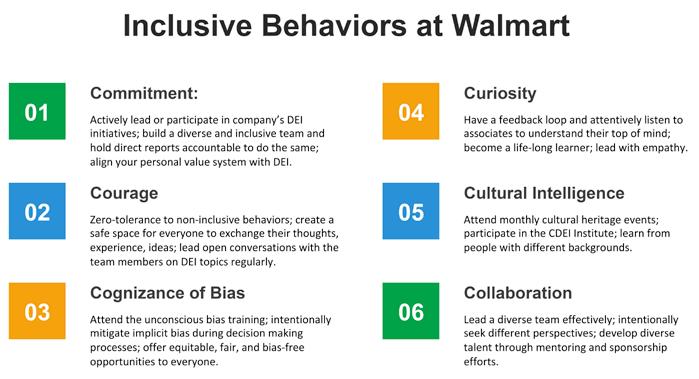
6. Collaboration: Do I empower others by obtaining diversity of thoughts, providing psychological safety, and concentrating on team cohesion?
To develop Inclusive Leadership and cultivate allyship at Walmart, more than 72,000 of our managers have Inclusive Leadership Expectations each year. They are required to do the following:
• Participate in approved Inclusive Leadership Education offerings
• Actively mentor at least 2 associates, host a mentoring circle, or participate as a mentor in a program such as Lean In Mentoring Circles
• Complete the Unconscious Bias in Hiring module
• Participate in using diverse slates/panels and internal posting standards
A Mentor-Matching tool backed by AI facilitates both mentors and mentees to find the right peer based on individual career interests, developmental needs, and personal profile. Walmart’s inclusive leadership curriculum and content library offers our team leads and managers training sessions and self-learning materials on various topics related to DEI. We recommend that all associates participate in the self-paced Race & Inclusion Learning Paths. And we encourage our male associates to choose from among more than 1,000 Lean In Circles, to have more
dynamic conversations and become advocates in advancing gender equity in our work environment.
The pathway for change involves leadership sponsorship, champions as role models and first followers, a sense of purpose, and grit for execution. By applying design thinking, we become intentional in devising programs and initiatives that contribute to mindset and behavior change.
was named a Top 32 Company for Diversity by DiversityInc in 2020 and among the Top 11 in Fortune’s World Most Admired Companies 2021.
We know we have more work to do. We will continue to invest in our associates, and help them remove barriers and achieve their career aspirations. We will concentrate on listening, learning, and elevating our associates’ voices, ensuring that we drive changes that will create a Walmart where everyone feels included and valued, and has an equal opportunity for growth, development, rewards, and impact.
Chief Culture, Diversity, Equity & Inclusion Officer Ben Hasan said, “If this year has taught me anything, it’s that none of us knows what tomorrow will bring. What I do know is that if we’re all committed to listening, learning, and leading, there’s hope that tomorrow will be a little more inclusive and equitable than today.” In sharing this common purpose,

Today, 40 percent of our CEO’s direct reports are women. In our U.S. operations, women make up 55 percent of our workforce, 47 percent of management, and 32 percent of corporate officers. Associates of color make up 47 percent of our total workforce, 37 percent of management, and 27 percent of corporate officers. Walmart

we all understand our obligation, feel part of the larger story, and are proud of our accomplishments along the journey. PDJ

Donald Fan serves as Senior Director in the Global Office of Culture, Diversity, Equity & Inclusion at Walmart Inc.’
By Vickie Thrasher, Senior Vice President Human Resources – Organization and People Capability, Oracle
It’s hardly news that the COVID-19 pandemic has hit the workforce hard worldwide or that it has disproportionately impacted women, including women of color. During the pandemic, this group suffered involuntary layoffs or were forced by childcare considerations to leave their jobs in huge numbers. In September alone, 865,000 women left the U.S. workforce—that is four times the number of men (216,000) impacted in the same period, according to U.S. Labor Department statistics.
Last fall, an executive with a U.K. charity that serves disadvantaged women estimated that pandemic-related loss of school and daycare services will set women back 10 years in terms of employment opportunities, according to The New York Times.
In this context, it behooves all of us to accelerate our efforts to support women, particularly women from underrepresented communities, in their efforts to enter the workforce and succeed once employed.
Here are some suggestions for how women—in this case represented by the fictional Susan Newhire—

can help themselves do well in the workplace, based on my two decades of experience as a human resource professional.
Asking questions and, equally important, listening carefully to the responses, is something HR professionals and hiring managers value in potential hires. I especially appreciate it if Ms. Newhire shows creativity in what she asks. As a prospective hire, if she takes the reins and departs from the usual FAQs about pay, benefits, and duties, and asks me, for example, about the hardest and/ or best parts of my job, I see a person who wants to know about me and my role, as well as about the niceties of the position she’s applying for. Never a bad thing.
I am a big proponent of mentorship. New employees, like Ms. Newhire, should try to find a person who shares her interests and can help her get up and running

as quickly as possible. Some companies call these buddy programs. Whatever the name, the goal is to support the new employee on her entry into the work environment. In my opinion, the gender of the mentor isn’t important, as long as he or she is a person who is willing and able to share time and knowledge, and takes an active interest in pushing the protégé’s career agenda.
Besides her immediate workgroup, Ms. Newhire should seek out other networking opportunities at the organization. Large companies like Oracle, for example, sponsor Employee Resource Groups (ERGs) for Women, LGBTQ+, Black, Hispanic, and Asian employees, as well as groups for veterans, cross-generational employees, and those with diverse abilities. These groups can be founts of information and support in navigating how to work best at a company.
And, depending on Ms. Newhire’s area of expertise, it can be rewarding for her to join other workgroups set up around that specialty, both inside and beyond the company. I would
recommend, however, that she start with groups inside her organization, while she acclimates to the new culture, before extending her reach to outside organizations.
As she builds her personal network at the company, it is also extremely smart for Ms. Newhire to keep in touch with colleagues who move on to other opportunities, both within and outside the company. It’s high time that women build a better and more powerful “old girls’ network,” after all.
Women often face genderbased obstacles in the workplace. But not all offenses are equal. If, for example, a male coworker repeatedly “mansplains” or talks over Ms. Newhire, whether she is his colleague, subordinate, or even his manager, it’s useful to try to suss out what drives his behavior.
It is possible that the mansplainer is not even aware of his tendency. If the interaction takes place in a collegial group, Newhire’s best response might be something tinged with humor, such as: “Wow, I agree with that, but maybe you should say you’re agreeing with me because I said the same thing five minutes ago!” If the man in question is doing this unconsciously, he will likely try to do better. (And if not, Newhire should keep prodding.)
If the atmosphere is not so


“Organizations that explicitly or inadvertently marginalize the voices of women or other underrepresented groups don’t just hurt the affected employees. They also impact their own ability to sell products and services to the broadest possible audience.”
friendly, she may be better off taking the conversation offline, perhaps soliciting advice—discreetly, of course—from coworkers. At some point, she may need to take him aside to say that his habit makes her job harder and stifles creativity. If that effort fails, Newhire should consider talking to his supervisor or, if the situation warrants it, to someone in HR.
Women sometimes tend to be less forthcoming about pushing their own thoughts and ideas for possible improvement. This may be due to a culturally induced sense of deference or lack of confidence. The sooner we all understand what might seem like a silly idea can lead to creativity and breakthroughs, the better for everyone. Many innovative products we use today, started off as ideas that were initially thought to be “unrealistic.”
That’s why it’s extremely important for employees like Ms. Newhire to be proactive about sharing their
thoughts for improving internal workflows and processes, as well as for products and services sold. And, getting back to that “old girls’ network”…. Once Newhire has achieved success in carving out her career, she needs to share her experiences with women who come after her, whether that is through mentorship, participating in ERGs, or through her professional networks.
We live in a hypercompetitive world in which every company— whether in high tech, manufacturing, entertainment, financial services, or retail—needs to expand its potential customer base for continued success. Organizations that explicitly or inadvertently marginalize the voices of women or other underrepresented groups don’t just hurt the affected employees. They also impact their own ability to sell products and services to the broadest possible audience. That is simply not good business. PDJ
Vickie Thrasher currently serves as Oracle’s senior vice president of HR. In her current role, she leads Oracle’s Organization Talent Development, Diversity Compliance and Inclusion, Employment Practices, Oracle Women’s Leadership, Top Talent Development, HR Strategic Communications, and Organization Design and Insights. Vickie joined Oracle Corporation in 1996 as an HR consultant and in 2000, she was promoted to vice president of business HR for North America Sales. As Oracle experienced exceptional growth, she was given additional responsibility, ultimately responsible for Business HR for the Americas. She has directed and led a variety of major initiatives in the areas of Talent and Performance Management, as well as M&A integration. With more than two decades of HR experience, Vickie has led HR teams across a variety of industries, including manufacturing, health care, telecommunications, and information technology.
Vickie attended Michigan State University earning a B.A. in Social Science, Labor and Industrial Relations and Saint Francis University of Pennsylvania earning a M.A. in Industrial Relations. She currently lives with her husband Greg, in the DC metropolitan area.

By Teshia Levy-Grant
In recent years, many organizations have focused on diversity, equity, and inclusion (DEI) initiatives. But renewed national attention on social justice is paving the way for more and greater change in 2021.
Data from employment and recruiting site Glassdoor shows that DEI-related job openings across all industries have risen by 55 percent since June 2020. Hiring DEI leaders is the first step, but continuing the momentum requires more action and support from leadership. Given the changing landscape and national awareness, the time is now for companies to engage and think outside the box to respond to the growing focus on diverse talent.
Internally, your organization’s DEI philosophy should be connected to your values. At Webster Bank, we are dedicated to respecting the dignity of every individual and acting with responsible and ethical behavior. These values are at the core of who we are, and our DEI efforts flow directly from them. We know that the diverse backgrounds and experiences of our bankers enable them to help our customers, and the communities in which we live and work, to achieve their financial goals.
Externally, it’s important for companies to specifically assess processes and procedures to ensure truly diverse employee populations, from recruiting new employees to retaining existing ones.
• Certify your frontline. From the very first contact potential candidates have with your frontline recruiters, they should recognize your company’s commitment to DEI. With diversity certification from providers like Advanced Internet Recruitment Strategies (AIRS), recruiters have the knowledge they need to build talent acquisition strategies and partnerships that can help locate diverse and under-represented candidates to fill open positions.
• Expand external networks To fill entry-level positions, look beyond the official career centers at colleges, and broaden your searches to include other groups. These are some of the ways that Webster is enhancing recruitment strategies:
o Campus multicultural centers. These organizations include people with diverse backgrounds and interests, and they have built trusted relationships with students. The leaders will usually know of individuals who might be a good fit for the positions you want to fill.
o The Federal TRIO Programs. Connecting with student services and reaching out to programs for individuals from disadvantaged backgrounds as part of your recruiting

efforts will allow you to include a larger population of low-income individuals, first-generation college students, and in some instances, students with disabilities.
o Professional associations and college networks. Tap into organizations centered on diversity, equity, and inclusion recruiting, such as local alumni networks, and sororities and fraternities, as well as professional recruiters in the DEI space.
• Invest in young talent programs. Internships are a good way to create a diverse talent pool for your organization. They provide college students or recent graduates with experience that will offer insights into your industry, and can help to identify students who might continue their careers at your company after they graduate.
• Partner with your community. Engaging in community networks can also lead to stronger diverse pipelines. One untapped source in most communities is churches, which can serve as a great vehicle for engagement and information sharing. You can also connect with philanthropic teams to partner in their efforts and build off their networks within the communities you serve. Reach out to your current employees
Make sure everyone, starting with senior leadership, is working toward integrating DEI into the way you do business, develop talent, engage employees, and get involved in the community.”
because many are engaged in community efforts and can serve as vehicles for information sharing, relationship building, and advertising.
• Consider remote positions. With widespread use of virtual tools to maintain remote and productive workforces during the COVID-19 pandemic, think beyond your general geographical area to broaden your search and potentially fill openings with individuals from diverse backgrounds.
• Align all areas with your DEI philosophy and goals Make sure everyone, starting with senior leadership, is working toward integrating DEI into the way you do business, develop talent, engage employees, and get involved in the community.
• Practice what you preach It’s not enough to give the corporate line regarding what is right. Your organization must live it. At all levels, everyone should be aware of all the ways your company lives its DEI philosophy, whether it’s knowing that your CEO chairs the diversity committee or that your organization donates money to support marginalized communities and work that centers addressing issues of racial inequity.
• Encourage mentorship. An effective approach for sup-
port and encouragement, mentoring can help guide employees along a positive and successful career path. So, make it easy for managers and leaders to mentor those coming up through the ranks with similar interests, backgrounds, and experiences.
• Make employee resource groups more robust. Many organizations offer various groups (e.g., LBGTQIA+, veterans, multicultural, etc.) that allow employees to explore individuality in an environment of personal and professional growth, and mutual respect. However, ERG success isn’t defined by increasing the number of groups your organization offers. It’s achieved by increasing engagement with the groups you already have. Ensure that they have executive sponsors and empower them to be allies in addressing the larger DEI goals and strategies of the organization.
• Expand educational events and activities. To encourage dialogue among employees, provide judgment-free opportunities. Book clubs and speaker series are just two ways you can educate employees regarding DEI issues and allow them to be heard while sharing their perspectives in safe spaces.
• Assess results. It’s not enough to mine data from your DEI efforts. In order to send a signal to the entire organization that DEI efforts are

indeed important, you must analyze the data and use it as the basis for change.
As we move into a new year, it’s important to realize that DEI efforts should not be performative, or a checkbox on a to-do list. Implicit bias is real. Empowered DEI officers will play a strong role in minimizing (and ultimately, eliminating) bias from organizational processes. That means getting comfortable with being uncomfortable—especially when it comes to ensuring that there is a diverse team of people at the table who are empowered and heard, and who feel valued and included in the decisionmaking processes.
There’s no one-size-fits-all approach to DEI. However, if you’re not explicit about your company’s stance, then you can be seen as complicit. Now is the time to think about how your organization approaches relationships and partnerships, and use these ideas to shape your own diversity, equity, and inclusion strategies. PDJ

Teshia Levy-Grant is senior vice president and diversity, equity, and inclusion officer, at Waterbury, Connnecticut-based Webster Bank. Levy-Grant leads Webster’s Diversity, Equity, and Inclusion Council and oversees the bank’s efforts to promote a diverse workforce in an open, inclusive environment.

Nearly two years ago, Sephora debuted its “We Belong to Something Beautiful” campaign, a public articulation of its longstanding company values. Through this, the company promised that it would continue working to make Sephora a place where all people feel they belong. At the same time, Sephora recognized that racially biased and unfair treatment exists broadly in our society, affecting all retailers, including its own stores.
Sephora’s diversity and inclusion mission is simple: to champion all beauty fearlessly, and to build inclusive environments for our employees, consumers, and communities. In 2020, Sephora established its holistic Diversity and Inclusion Heart Journey to support the vision of becoming the
Diversity, Inclusion, and Equity Champion in the retail industry.
The Black Lives Matter movement and the global conversations regarding racial justice last year only increased the urgency of this work and made it clear that we all have more work to do.
Sephora’s Diversity and Inclusion Heart Journey focuses on three key pillars: employees, consumers, and communities. The retailer will dedicate its efforts, now and in the future, to creating spaces and opportunities that celebrate, respect, and honor everyone’s unique beauty.


Below are some of the most recent actions taken by Sephora to continue driving toward the retailer’s goal of becoming the world’s most inclusive beauty community:

• In mid-January, Sephora released the results of the firstever large-scale U.S. study on Racial Bias in Retail, which was commissioned in 2019. The goal of the study was to measure the
problem of racially driven bias as it affected the shopper experience and identify opportunities to end unfair treatment and create an environment that truly serves all. Drawing upon the Diversity and Inclusion Heart Journey and the study’s findings, Sephora designed an action plan focused on three key areas—marketing and merchandising, the in-store experience and operations, and talent and inclusive workplaces— with the goal of mitigating the negative effects of bias. To learn more about the study’s findings and the resulting action plan, please visit: www.sephora.com/ diversity-and-inclusion
talent pools and fostering a more inclusive workplace for all. Sephora has created accessible environments that welcome talent with disabilities across its five distribution centers. By the end of 2021, people with disabilities will account for 12 percent of the workforce in its distribution centers.
• In June 2020, Sephora was the first major retailer to take the 15 Percent Pledge and dedicate 15 percent of its assortment to Black-owned brands. By the end of 2021, Sephora is committed to doubling that percentage.
• Each month, Sephora features key nonprofits within its marketing channels, building awareness for their efforts to drive equity and inclusion, and inviting Sephora clients to join. Clients may contribute by redeeming their Beauty Insider points as donations; they have redeemed more than 150 million points as donations since this program’s launch in 2020.
• In August 2019, Sephora established Equity Advisors and Partners, an advisory group consisting of leading individuals and top social justice and civil
Sephora’s diversity and inclusion mission is simple: to champion all beauty fearlessly, and to build inclusive environments for our employees, consumers, and communities. ” “
• Sephora also participated in the Pull Up for Change challenge, disclosing leadership demographics and committing to increasing representation across all levels of the organization. To build on this, Sephora’s goal is to double its representation of Black leaders to mirror the number of Black employees, who currently make up 14 percent of its workforce. Sephora will broaden recruitment and career advancement processes for employees of color by expanding upon its existing partnerships, while also launching customized coaching and mentoring programs.
• The retailer is also leading the way in offering career opportunities to underserved
• Building on this, Sephora recently announced its 2021 Accelerate Cohort, which was originally founded to cultivate female-owned brands, but has since evolved to focus on BIPOC-founded-and-owned brands. The program will offer a robust curriculum, as well as mentorship, merch support, potential funding, and investor connections, to all involved. The goal is to provide these founders with a community and ecosystem that supports their launch and long-term growth at Sephora.
Sephora is committed to supporting equity, justice, and inclusion within our communities through charitable giving initiatives and strategic partnerships, including these:

rights organizations who work at the intersection of race, equity, and culture. Their counsel helps shape Sephora’s work on equity and the way the retailer shows up in the beauty industry and beyond.
Sephora is prepared to hold itself accountable to the community and its team members. As such, the company is implementing a new D&I In-store Experience Dashboard that will provide analytics on client service and feedback to stores on a monthly basis in order to measure employee training participation and efficacy. Sephora will also share its progress broadly bi-annually against these actions on Sephora.com. Please visit www.sephora.com/ diversity-and-inclusion to learn more. PDJ
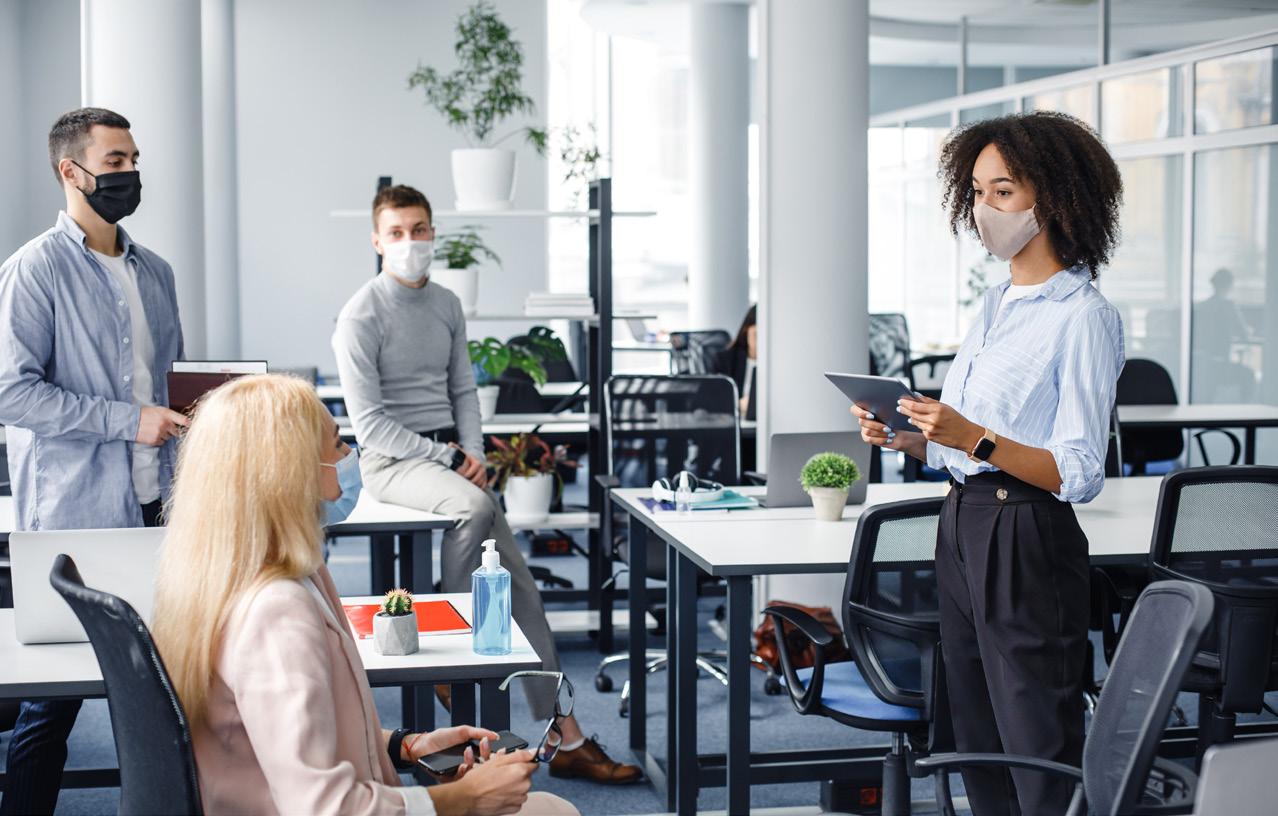
By Janet Crenshaw Smith and Gary A. Smith Sr.
It’s easy to feel helpless and out of control right now. We have been through so much. We did not see the pandemic coming, often feel like we can’t do anything about it, and we can’t be sure what’s next. Amid the crisis of the pandemic, we’re still experiencing social unrest that is continuing to fuel more interest in and expressions of commitment to diversity, equity, and inclusion (DEI). It has been almost one year since the public killing of George Floyd. Many of us have not yet seen proof of the DEI improvements that were promised. But know this: When it comes to the topic of DEI, you are neither helpless, nor out of control, nor powerless.
Now is the time to exert the power you have.
The power to say something when you see something
We had to admit that we had underappreciated the huge volume of people who are having a brand-new, very-first-time, awakening about the realities of inequities in the workplace and beyond. A generation of Baby Boomers who were taught to be “colorblind” evidently took that literally. They did not notice race (and other diversity dimensions) and when it was absent in boardrooms and leadership teams, excluded from opportunities and awards, and overrepresented in poor performance ratings, penalties, and punishments, they assumed it was due to fair systems doing their thing of filtering out the inferior and welcoming in excellence.

Some of you are pausing and calling “foul!” or maybe even thinking “that’s bullsh*t” right now. I get it. But imagine, just for a moment if you can, that many folks truly did not realize what was happening. What if they did not understand the inequities in decision-making and outcomes? And what if no one was telling them? Two very different realities coexisting at the exact same time. “I didn’t know,” literally colliding with, “How could you not know?”
There have been severe breakdowns in the systems that should have documented and reported gaps and inequities. Many organizations are undertaking quantitative assessment work for the very first time. They are often surprised and shocked with
Humans who have unconscious bias create biased systems that lead to inequitable outcomes. You have the power to put a spotlight on the gaps, to create awareness, which is the first step in dismantling biased systems.
the findings. They didn’t know. They believed they were operating meritocracies—fair, merit-based systems that different people simply weren’t good enough to succeed in. They never questioned the stories they told themselves, assuming they even took the time to ask the question, “How can whole groups of people be missing?”
So where and what is your power in all of this? Say something. Humans who have unconscious bias create biased systems that lead to inequitable outcomes. You have the power to put a spotlight on the gaps, to create awareness, which is the first step in dismantling biased systems. Speak up and declare, “This is not fair. Let me tell you how things work here.” Reveal, “We are not a meritocracy, and here’s how the subjectivity shows up.”
Employee referrals, and unpublicized jobs via word of mouth, continue to be the largest source of new hires for most companies. Employees sourced from employee referrals tend to stay at the organization longer, onboard more easily, and are usually a better “fit.” That’s not only because of the candidates themselves. It’s often because the referred candidate knows more about the organization and its culture than a typical candidate.
Here’s the problem. People of color are disproportionately underrepresented in the referral process. They are not referring at the same proportional rates, nor are they being referred. When someone says, “I can’t find anyone,” dip into your diverse network and identify people to refer. Pay attention to the story you tell yourself about why you are not referring more people. Don’t sleep on this one.
Feedback—specific, timely, and direct—is a gift. Yet when you’re different, you often miss out on helpful insights and guidance that others receive. It’s not easy to give anyone feedback, but it’s even more difficult when diversity is involved. What makes it difficult? Sometimes it is believing that the receiver may become defensive, show emotions, or perceive that you are criticizing them because they are different. Other times it is difficult because it’s not your official role and you don’t want to get involved.
Create a culture where feedback is seen as a gift, where withholding feedback is withholding something that has value. That means growing in our ability to give and receive feedback. If it’s the gift we say it is, then whether giving or receiving, there are no losers when feedback occurs. Then do your part. Make a difference.
Whether taking care of yourself means saying yes or saying no, exert your power to examine your needs and do your best to provide for yourself. Now more than ever, it’s time to care for yourself—physically, mentally, emotionally, and spiritually. Pay attention to the resources available to you that you may have, up until now, ignored. Ask for help. The irony here is that asking for help requires being self-aware, secure in yourself, and willing to be vulnerable—the very traits and behaviors that may leave us in difficult times. It is okay to say to yourself, “I’m going to take care of me.”
The Serenity Prayer is commonly quoted as follows: “God grant me the serenity to accept the things I cannot change, courage to change the things I can, and wisdom to know the difference.”
May you be granted the serenity to recognize your power and find your authentic voice, and use them both wisely for the benefit of yourself and others. PDJ

and Gary
are the cofounders of Ivy Planning Group, a 30-year-old consulting and training firm. They were recipients of PDJ’s 2020 Black Leaders Worth Watching Award, and were named Diversity Pioneers. In 2018, Ivy Planning Group won PDJ’s Innovations in Diversity Award.

By Michael Bugeja
Over the course of my academic and professional career, I have tried several methods to increase awareness about diversity and inclusion in my large-section media ethics and technology classes. I also am a frequent speaker in business and organizational meetings. The challenges are the same. Typically, lecturing about the importance of diversity is insufficient. While speeches do inform about concepts associated with racism and stereotypes, too often they fail to inspire discussion and introspection, necessary components of engagement.
Engagement involves emotions. But emotions can backfire in the classroom if they involve persuasion, politics, and passion, especially by the instructor. Students distrust persuasion, politics evoke correctness, and passion entails risk of offense. Any one of those outcomes can stifle or silence discussion.
Emotional intelligence asks us to feel, affirm, and question our own perceptions, values, and convictions.
In 1988 at Ohio University’s Scripps School of Journalism, I asked students of color to meet privately with me before class. I shared what I intended to do in my predominantly white classroom, inquiring whether they would participate in an exercise that might change attitudes. They agreed. I provided each with a slip of paper and asked them to remember a time when they
experienced racism, jotting down one word that summarized the experience. They provided me with this list: Broken Discouraged Confused Disheartened Defensive Angry Betrayed Demoralized Crushed Shattered Hurt Frustrated
Then, we entered the classroom.
About 100 students were assembled in the Scripps auditorium. I announced the following from a prepared script:
“Remember a time when you had important news to tell to someone you trusted or felt was your friend—a parent, a coach, a pastor, a cleric, a counselor, a roommate, a partner, a boyfriend, or a girlfriend. It could be an achievement. Perhaps an exciting internship or travel opportunity. You shared that news enthusiastically. Your confidant didn’t celebrate with you but said something completely unexpected—a put-down or negative response—exactly the opposite of what you had anticipated. In one word, how did that make you feel when it happened?”

As you can see, the question has little to do with diversity and inclusion, but much to do with experience and emotion. Students of color didn’t respond during the initial discussion. Others raised their hands, recalling myriad disappointments. I put each of their words on the chalkboard.
When discussion ended, I circled words my students of color had previously provided, explaining my motive—how racism feels. Although I did not record student responses the first time I tried the experiment, I do recall that several words (“angry,” “demoralized,” “frustrated”) appeared on both lists.
I used that original list each year in ethics classes at Ohio University and, later, at Iowa State University.
I tell my students, “You might not experience intolerance or bias, but now you can relate to how it feels—the first step in understanding racism, bias, and exclusion. Now imagine if you felt this hurt on a regular basis. How might that affect you?”
White students who shared words about disappointment had no idea they were participating in a diversity exercise. Afterwards, the entire class discussed the cumulative impact of hurtful words, associating them now with exclusion. Discussion became more focused and insightful, indicating higher levels of emotional intelligence.
I have used the list in speaking engagements with professionals with similar results. It has
Open discussion inspires introspection as we explore who, what, where, when, why, and how attitudes about race were formulated. ”
always proved to be a great discussion starter.
Open discussion inspires introspection as we explore who, what, where, when, why, and how attitudes about race were formulated.
Journaling allows people to express or record their feelings in private. Writing about feelings and experiences often elicits important hitherto unexplored truths. Here’s the exercise, which can work in any academic or professional setting:
I. Personal Assessment. Contemplate the following:
1. List the highs, lows, and turning points about race, sex/gender, disability, and social class in your:
• Life
• Family
• Workplace
• Community
2. Analyze your list by addressing the following:

• What epiphanies, truths, or lessons did you learn from each high, low, and turning point?
• What falsehoods, if any, were associated with each?
• How do incidents, truths, lessons, and falsehoods relate to diversity (or lack thereof) within your life, family, work, town, country, world?
• How have they enhanced or biased your conscience?
• How have they enhanced or biased your consciousness?
• How can you apply lessons based on truth in your life?
II. Personal Valuation. Contemplate the following:
• When introducing truths about race, sex/gender, disability, and social class or other such societal concerns, do you present your best or your ordinary self to others? For example, how do you introduce such material at work, at home, at school? Do your representations differ in each venue, and if so, why?
• Are you avoiding discussion of sensitive or potentially controversial issues and if so, why? Peer pressure? Fear of mistakes? Anger? Approval-seeking? What can educators, coworkers, and supervisors do to make you feel more comfortable engaging in discussions about race, gender, or social class?
III. Summary Assessment. Writing Assignment:
• Based on your truths and analyses in sections I and II, and without violating your own or someone else’s privacy, write a short essay explaining how this exercise helped you understand your feelings about bias, whether people or events in your past shaped your attitudes, and why you do or do not speak out about diversity and inclusion.
I do not share or respond to assessments out of privacy concerns. The exercise is ungraded for that reason. But they do inform me about what I should cover in class to make a lasting impression. Often, dominant factors shaping attitudes and beliefs stem from family upbringing, peer pressure, chance encounters, or inadvertent race-based mistakes and subsequent embarrassment. Over time, assessments increased my own awareness, informing lectures and discussions. PDJ
Michael Bugeja, distinguished professor of journalism, won his college’s 2017 diversity award. He also has twice won the distinguished Clifford Christians Award for Research in Media Ethics. Under his directorship in 2015, Iowa State’s Greenlee School won the national Diversity and Equity award bestowed by the Association for Education in Journalism and Mass Communications.
Bugeja, who teaches media ethics, and technology and social change, has published 24 books across genres, including three books by Oxford University Press: Interpersonal Divide: Searching for Community in a Technological Age; Interpersonal Divide in the Age of the Machine; and Living Ethics Across Media Platforms. His latest work is Living Media Ethics: Across Platforms, Routledge/Taylor & Francis, 2019.

By Meenakshi Das
Idon’t think people realize how many different types of disabilities there are. People in wheelchairs or wearing hearing aids are noticeable. However, people with invisible disabilities, such as chronic illnesses or depression, are harder to spot. And those of us with a disability find it surprisingly difficult in what purportedly is an “inclusive and diverse” society to find companies that want to hire us.
Although the Americans with Disabilities Act (ADA) was passed in 1990, disabled people are still challenged to find jobs that fit their education and training. But, it’s a two-way street. We don’t know how to ask for what we need because what we need hasn’t been invented, or we are afraid we won’t get hired
or could get fired if we do. On the other hand, companies don’t always understand what workplace modifications or assistive technologies may be required. They may fear that such modifications will be expensive (although some workarounds are surprisingly inexpensive) and worry about the extra time required to make them. They may also wonder how we really would “fit in.”
Hiring disabled people might appear to be just “one more thing,” but data show it’s worth the effort on many levels. The most important reason to hire disabled people to make products and provide services is this: Companies want to sell their products and services to the one billion disabled people on this planet.

I grew up with a severe stutter since the age of five. Fast forward to my first campus job interview in 2015; the recruiter assumed that my stuttering was a sign of low proficiency in English. More important, even though I have a bachelor’s degree and am now working toward a master’s degree in computer science, some people think my disfluency is a reflection of low intelligence. Microsoft disagrees. After obtaining my master’s, I will be working there as a software engineer. Many teachers silenced me when I was a child and excluded me from activities because I took too long to speak. But I dreamed of studying in the United States and was given a
scholarship to study here because someone believed in me. Mentoring meant everything. Early in my college experience and internships, I suspected I was not the only one whose disability had been mistakenly seen as a sign of subpar intelligence. I decided to become an advocate for people like me, and I started a blog and social media accounts to help disabled individuals in tech. I represented Alabama as a young disability advocate on the 30th anniversary of the Americans with Disabilities Act. (https:// rudermanfoundation.org/link20/ celebrating-30-years-of-ada/) In 2019, I founded a support
every day—but not every piece of technology is disabled user-friendly.
As I became more interested in how companies might embrace disability inclusion, I became a spokesperson and advocate for the cause. Forbes magazine mentioned me in a 2019 piece on disability rights, as did CNET and ABC News during the pandemic. “Disabled people are innovative because they already know of solutions to work around their disability to get work done,” I told ABC News. The statistics from an Accenture report titled Getting to Equal 2020: Disability Inclusion stated, “Among the companies
including the phrase “Equal Opportunity Employer” in their outreach, and make every part of their hiring process inclusive, starting with an accessible job portal. Disability disclosure is a personal choice, and one does not need to disclose a disability to request accommodations. Nevertheless, companies must strive to create a sense of trust and inclusion among employees. Senior leadership must work to remove any barriers to, and secure buy-in for, accessibility throughout their organization.
Being an advocate and mentor for disabled people in the workplace has been very
“
If companies want to attract and hire disabled employees, they need to go beyond including the phrase “Equal Opportunity Employer” in their outreach, and make every part of their hiring process inclusive, starting with an accessible job portal.”
group called Working with Disabilities (now, with more than 1000 disabled members) after being a council member for Disability:IN, a leading nonprofit resource for business disability inclusion worldwide.
Calling attention to the issue
Through the years, I realized that there was a lot of misinformation. “Assistive devices” that were crazy expensive ($5000+) could easily be replaced by a $2 or $3 phone app. In my case, I use a Delayed Auditory Feedback phone app while giving presentations. Technology empowers disabled people
in our study, the organizations most focused on disability engagement are growing sales 2.9x faster and profits 4.1x faster than their peers.” Meanwhile, the American Association of People with Disabilities (AAPD) and Disability:IN have both said that U.S. GDP could get a boost of $25 billion if more of people with disabilities join the workforce. Many organizations and people with disabilities seek ways to level up and find ways to access this win-win.
My advice
If companies want to attract and hire disabled employees, they need to go beyond

satisfying. And I think I’m making a difference. In the end, diversity and inclusion are not just about good business. They are the right thing to do. PDJ

Meenakshi “Meena” Das is a master’s student studying computer science at Auburn University. She draws on her life experiences as a woman who stutters and her education in computer science to explain why it’s critical for us to work toward accessibility in academic institutions and the tech field. For more information, please email Meenakshi “Meena” Das here: meenakshidas1112@gmail.com.
13th Annual Diversity Leader Awards
Every year, since PDJ began celebrating organizations and individual Diversity Leaders who are committed to taking diversity to the next level, we have been impressed and encouraged by their commitment, their intelligence, and their creativity.
The Diversity Leaders we recognize in the following pages are reaching out, locally and globally, to embrace an ever-expanding variety of employees, vendors, clients, and communities. Diversity, inclusion, and equity are central to everything they do. For many, who at one time or another have felt excluded or ignored because they belonged to a particular gender, or ethnic or cultural group, making diversity a reality is a personal imperative.
This year’s Award recipients are working to connect with a more diverse group of potential hires, reaching out to women- and minority-owned vendors, supporting their communities, and teaching company leaders and hiring managers to recognize and confront their own unconscious biases. Most important, they are cultivating workplaces that invite all employees to bring their authentic selves to work every day.
We invite you to get to know these extraordinary Diversity Leaders. You may discover ideas and strategies that you can use to help drive your own organization along the diversity highway. And we know you’ll be inspired by their insights, their enthusiasm, and their inspiring personal stories.










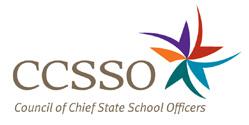
Council of Chief State School Officers (CCSSO)
Headquarters: Washington, DC
Industry: Education Policy Nonprofit
CEO: Carissa Moffat Miller, PhD
As the Chief Executive Officer of the Council of Chief State School Officers (CCSSO), I strive to ensure CCSSO’s work is grounded in diversity, inclusion, and equity. Many women and people of color paved the way for me to become the first person in my family to go to college, earn a doctorate, and become the first woman to lead CCSSO. Among my first actions as the leader of CCSSO, I expanded my leadership team to hire our organization’s first chief equity officer, and to include more women and women of color, with the intent to mentor and strengthen women as leaders. It is critical that we soon reach a day when we no longer need to recognize these as “firsts,” because they should be norms in all industries and sectors of our society. All of our children, particularly girls and children of color, must be afforded the same—and even better—opportunities in the years to come to make sure positions of leadership equally represent the communities we serve.
I remain committed to making many more “firsts” possible for the students we work hard to serve every day.
– Carissa Moffat Miller, CEO
The Council of Chief State School Officers (CCSSO) is a nonpartisan, nationwide, nonprofit organization of public officials who head departments of elementary and secondary education in all 50 states, the District of Columbia, the Department of Defense Education Activity, and five U.S. extra-state jurisdictions. CCSSO provides leadership, advocacy, and technical assistance regarding major educational issues. The Council seeks member consensus on major educational issues and expresses those views to civic and professional organizations, federal agencies, Congress, and the public.
Members look to the Council of Chief State School Officers to help them drive their own equity initiatives, and CCSSO is committed to incorporating equity into all its work in order to yield more equitable internal and external outcomes. Receiving PDJ’s 2019 and 2020 Diversity Leaders Award has allowed CCSSO to present its equity efforts to funders and corporate sponsors, which, in turn, has resulted in funding to support CCSSO’s development of the frameworks, tools, and resources identified in its Aligning Equity for Impact: 2-Yr Plan.
Chief Equity Officer Holmes ensures that personnel practices are aligned with an overall commitment to equity, diversity, and inclusion. The organization has also created a voluntary diversity, equity, and inclusion committee whose purpose is to engage staff in enhancing workplace equity and encouraging inclusive voices in providing diversity-related staff training. It is crucial for organizational leaders
to identify the need for diverse representations in the C-Suite and the boardroom. Next, as we learn more about how identity impacts one’s experiences in life, it is imperative that executive leaders commit to lifelong learning in the D&I space. Lastly, since capacity is critical in the D&I space, organizations must continue to put resources behind those leading D&I strategies. By broadening the chief equity officer portfolio at CCSSO, the organization has been able to add capacity and be more strategic regarding collaboration for cross-Council initiatives.
Because CCSSO values diversity, equity, and inclusion, the chief equity officer reports directly to the chief executive officer and is a part of the executive leadership team. D&I initiatives are communicated to the board through email updates and agenda items on board calls. Also, during his or her year in that role, each board president adopts a platform that focuses on educational equity. CCSSO employs multiple platforms, including Microsoft Teams, staff meetings, and an internal intranet site, to ensure two-way communication with employees about Council equity initiatives. Externally, the organization communicates Council D&I values through the use of social media, op-ed articles, journal entries, and the CCSSO website.
As a nonprofit, transformative funding is a real concern. CCSSO accomplishes its goals through leading, convening, and influencing. We leverage multi-year transformative funding in order to impact the one industry that touches every human.

Annie Holmes Chief Equity Officer
Her Credentials: BS, Temple University; M Ed (2) & PhD (ABD), Pennsylvania State University
Her Philosophy: Empowered Black Women Empower Black Women.
Annie Holmes and her team produced an internal Equity Summit to onboard all staff into the equity approaches that would be implemented going forward. They also were able to work with state education policy leaders to address systemic racism within the education system. And finally, they were able to convince 26 states to establish an equity leader position within the state education agency.
In 2021, Holmes plans to continue to build out additional strategies and policy shifts that will achieve even greater racial equity across the education system.



Headquarters: Philadelphia, PA & New York, NY
Industry: Law
CEO: Henry Nassau
This is a painful and fraught moment in history, but we cannot give in to despair. Many of our colleagues are personally affected by these recent events and have too often experienced discrimination in their own lives. We must respond in the way that we as a community always do: listen and support one another and, just as when our clients’ problems are more difficult than expected, work harder. The search for justice has always been fueled and enabled by the law. We cannot turn away now simply because the task has become more complicated, or will take longer than we anticipated.
– Chair Andy Levander & CEO Henry Nassau
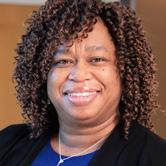
Satra Sampson-Arokium Chief Diversity & Inclusion Officer
Her Credentials: Masters of Public Administration, Marist College; BA, political science, State University of New York at Albany
Her Philosophy: “People will forget what you said, people will forget what you did, but people will never forget how you made them feel.” – Dr. Maya Angelou; Take the time to listen, and always treat people with dignity and respect.
Dechert publicly condemned the tragic and unconscionable murder of George Floyd and countless others. In response to Black Lives Matter, the firm’s diversity team planned and implemented a comprehensive employee program to deepen our understanding of racism, anti-racist practices, and ally-ship. The program included a Diversity and Inclusion Toolkit; Juneteenth—A Day to Reflect and Recharge; Virtual Forums for Black Employees; and Stand Against Racism Town Hall and Speaker Series.
In 2021, to improve associate retention, especially for diverse and women associates, and promote a culture that fosters diversity, equity, and inclusion, Dechert will launch a mentoring program, plan a work allocation system, build on its town hall and racial justice series, continue interactive sessions on inclusive leadership, launch and train a new class of diversity liaison partners who will oversee D&I efforts in their respective practice groups, and host a virtual Diverse Lawyers’ Symposium and a Sponsorship and Sustained Support program for senior female associates, counsel, and partners.
As a leading global law firm with 26 offices around the world, Dechert views diversity and inclusion as a core component of the firm’s constitution and the responsibility of all Dechert personnel.
Each year, firm leaders dedicate time to intense interactive sessions on inclusive leadership at the firm’s Partner Retreat, an annual gathering of Dechert’s partners from around the world. In 2020, the program was expanded to associates and business service professionals, and topics included affinity bias, attribution bias, covering, in and out groups, priming, and unconscious bias. The most recent session focused on inclusive leadership in times of crisis, in response to both the global pandemic and the Black Lives Matter movement.
Dechert’s formal D&I Strategy program includes a director, a manager, a senior specialist, a specialist, and a global talent assistant. Together, they are responsible for strategic oversight and implementation of the firm’s D&I initiatives.
The Diversity & Inclusion Committee, comprising 20 members, oversees policies and procedures that support the D&I strategy.
Diversity liaison partners, who oversee the D&I efforts of their respective practice groups, monitor assignments for equitable distribution of opportunities and workflow, and ensure that diverse individuals are mentored and sponsored, advised on their development, and promoted internally and externally.
Dechert’s Asian, Black, Family, Greater Middle Eastern, Latino, LGBTQ, and Veteran affinity groups, in addition to its Global Women’s Initiative, support the development and retention of diverse attorneys.



Ernst & Young (EY)
Headquarters: London, England
Industry: Professional Services
CEO: Carmine Di Sibio
At EY, we have been on our own path to close the gender gap. These efforts are part of our firm strategy, which also includes our broader goal of advancing diversity and inclusiveness. Over the last few years, we’ve intensified that work by laying out a D&I roadmap for success, which I sponsor, along with the Global Head of Diversity & Inclusiveness at EY. The aim is for everyone—individuals, teams, and leadership—to design, track, and advance our progress. We’ve made some important strides, learned a lot along the way, and are committed to our plan.
– Carmine Di Sibio, EY Global Chairman and CEO
EY works hard to stay connected to and aware of the feelings and needs of its diverse workforce. To that end, we regularly conduct our Global People Survey to confirm that formal and informal cultures match, which helps guide our D&I journey in the most efficient direction. We also issue short People Pulse surveys on a quarterly basis to stay abreast of top-of-mind issues and concerns of EY people around the world.
We continue to keep D&I highly visible to our people and ensure that D&I is a positive driver to the growth of our business. This can be seen throughout our culture and in the initiatives we act on.
Some of our D&I actions are shared with our people through direct communications from senior leaders, including our global chairman and CEO, through all-hands calls and firm-wide emails. The firm also regularly shares updates about D&I progress, new initiatives, and learning opportunities through internal newsletter articles. For instance, the firm just launched Inclusive Leadership for All, a global training course designed to help our people become more inclusive leaders and team members.
At EY, we strive to provide equitable opportunities to all members of our diverse workforce. We encourage sponsorship, along with access to growth assignments, to help increase the representation of women and ethnic minorities in leadership ranks.
The firm is also committed to equity for partners and staff. Equity in opportunities, advancement, and compensation is a business imperative, and we strive to promote fair practices for all our people, across all genders and other dimensions of diversity.

Karyn Twaronite Global, Americas & US Diversity & Inclusiveness Officer
Her Credentials: BS, accounting, Miami University of Ohio; MS, taxation, Fordham University; Strategic Human Resource Management certificate, Harvard Business School; licensed Certified Public Accountant (CPA), state of New York
Her Philosophy: Creating a sense of belonging is pivotal to aligning business practices with a commitment to social progress. And when different voices join together, they can pave the way toward a more sustainable and inclusive future— not only driving a lasting impact on business, but also on our communities.
In 2020, my team worked to evolve D&I efforts in response to the COVID-19 pandemic. Our efforts included the following: promoting inclusive leadership practices, providing digital tools, offering resources, and helping facilitate connection points for those disproportionately impacted by world events; supporting EY’s efforts in the United States to help eradicate racism and discrimination against the Black community; leading the creation of EY’s Global Social Equity Task Force; sponsoring and helping to launch the EY Global Executive Diversity & Inclusion statement; spearheading efforts to update the company’s values to explicitly incorporate inclusiveness; and working to update EY’s Global Code of Conduct to further reflect inclusiveness as a core expectation.
While EY continues to navigate both the global health and social crises, we understand some of our D&I priorities might change directions in order to respond to important issues certain populations are facing. As the COVID-19 vaccine rollout continues and some return to the office, while other continue working remotely, EY must be prepared to address the cultural ramifications that come with hybrid teaming and company leaders must work together to ensure that opportunities are equitable, differences are valued, people feel supported, and all voices are heard.



Headquarters: Palo Alto, California
Industry: Technology
CEO: Enrique Lores
At HP, our long-held belief is that we should leverage our company and our abilities to leave a Sustainable Impact on the planet, our people, and local communities around the world. Protecting the environment and supporting diversity and inclusion are good for business and good for all of us. Since our company’s founding nearly 80 years ago, sustainability, diversity, and inclusion have been tightly woven into our DNA and guide the business decisions we make. We will always advocate and prioritize policies and programs that advance this agenda, while at the same time protecting human rights for everyone, everywhere.
– Enrique Lores, CEO

Harvey Anderson General Counsel
His Credentials: Bachelor of Science, civil engineering, Marquette University; Juris Doctor, University of San Francisco School of Law
In mid- 2020, Harvey Anderson and his team implemented the Mansfield Rule for HP’s legal functions. In committing to the Rule, HP will be challenged to “walk the talk” and demonstrate substantive progress in redefining its strategy to source top diverse talent.
HP also launched a taskforce on Racial Equality and Social Justice. Anderson plays a key role in leading the taskforce’s work across three main pillars: people, industry, and local and national.
In 2021, Anderson’s team plans to expand the reach of diversity and inclusion efforts and make progress against the goals of HP’s taskforce on racial equality and social justice, notably, to double the number of Black/African American executives by 2025, raise Black/African American representation at HP to industry levels, and double the number of Black/African Americans in technical roles.
Anderson’s team will also continue driving toward Mansfield Certification, engage leaders and employees to grow the company’s Business Impact Networks, engage diverse communities, promote STEM education and career opportunities for diverse students, and foster inclusive work environments where employees are empowered to innovate and grow their careers.
HP’s success is driven by the power of its people. Corporations who prioritize diversity position themselves to better understand and respond to the needs, experiences, and motivations of customers. To succeed as a global company, we must represent and encourage people from different countries, races, ethnicities, genders, religions, sexual orientations, ages, and all other demographics.
HP is proud to have one of the most diverse Boards of Directors in technology. Our directors care deeply about accelerating our business by embracing diversity, inclusion, and sustainability, along with all facets of our business.
We are driven to make HP the destination of choice for top talent, including women and underrepresented groups. In recent years, we have achieved a six percent increase in women in executive-level roles. In many global functions, including legal, finance, HR, and marketing, women now represent more than 55 percent of our employee base.
We create a diverse and inclusive environment by elevating awareness of unconscious bias in our management training, improving diversity hiring, and ensuring pay equality.
Diversity and inclusion shape our way of thinking and operating. More innovation and more creativity will come from groups that represent the areas of the world that we serve. This guiding principle helps drive the bottom line of our business and ultimately, we believe, benefits the communities where we live and work.




LinkedIn Headquarters: Sunnyvale, California
Industry: Public Company
CEO: Ryan Roslansky
At a time of global focus on racial injustice and a pandemic that has disproportionately affected Black and Latino communities in the United States, along with other marginalized communities worldwide, the work of economic equity has never been more important.
At LinkedIn, we believe companies—as the enablers of wealth creation and professional mobility—must play a leading role in building a more equitable future for all.
– Ryan Roslansky, CEO
As an organization that exists to create economic opportunity for the entire global workforce, LinkedIn recognizes the organization’s responsibility to help build that future, both within its workforce and for hundreds of millions of members and customers. In the long term, this means building towards a world where professional organizations are a reflection of the communities in which they operate.
Its Diversity, Inclusion, and Belonging strategy begins with LinkedIn’s workforce, with an ongoing focus on increasing representation of underrepresented communities and building an environment of inclusion and belonging at LinkedIn.
Beyond inclusive hiring, LinkedIn puts a heavy emphasis on retaining and growing people from all backgrounds. One way to do this is through mentorship and professional development programs geared to address the career paths of women globally and Black and Latino employees in the United States. Programming examples include:
• Women’s Initiative (WIN)–Incubated in LinkedIn’s sales organization, WIN produced a 66% increase in female leadership over four years; now expanding WIN’s scope across all G&A functions
• Women in Tech (WIT)–Committed to achieving gender equality in technical roles
• LinkedIn Engagement and Development program (LEAD)–Aimed at attracting, engaging, and developing Black and Latino talent in the U.S., with plans to extend to underrepresented ethnic groups internationally
• Evolving the organization’s leadership and governance model to better leverage LinkedIn’s 9 ERGs in developing future leaders

Rosanna
Durruthy
Vice President, Global Head of Diversity, Inclusion & Belonging
Her Credentials: BS, government and humanities, Harvard University; LGBTQ Executive Leadership Program, Design Thinking, Stanford University–Graduate School of Business
Her Philosophy: Belonging isn’t something any of us create for ourselves; it’s the product of a shared commitment.
In 2020, Rosanna Durruthy and her team launch a key initiative to achieve a diverse slate of candidates, inclusive of Black, Latino, and female talent, at all stages. They saw a double-digit increase in the achievement rate of diverse slates for hires year-over-year. The team piloted a new hiring program that recruited and hired people without traditional customer support backgrounds for our Customer Operations team. TransformHER events in 2020 created a forum to uplift women of color and their allies, which included more than 4,000 live participants and more than 100,000 viewers on replay. In the UK, an ongoing series of LinkedIn events focused on introducing Black professionals to opportunities at LinkedIn, while also offering opportunities to build skills and network. Led by Rosanna Durruthy, LinkedIn’s Diversity, Inclusion, and Belonging goals are industry leading in women representation across industry averages. Four years ago, less than a third of LinkedIn’s leaders were women. Now, women represent nearly 42 percent of leadership—a 12 percent increase in the past two years, and 34 percent in the past four.
In 2021, the team’s top talent initiative will be focused on developing people managers who are world class at inclusive leadership. Along with being responsible for hiring and promotion decisions, and coaching and developing the people on their teams, these people managers will be setting the tone for an inclusive culture. The practices and principles Durruthy’s team applies will help build a culture of belonging for employees from many historically marginalized backgrounds. They will also launch a series of learning sessions in LinkedIn’s India, Japan, and China offices, focused on building an inclusive environment for people with disabilities.



New American Funding
Headquarters: Tustin, California
Industry: Direct Mortgage Lender
CEO: Rick Arvielo

The New American Funding family is made up of diverse people of all genders and identities. Women make up 60 percent of all employees with many holding C-level positions, 45 percent of all employees are minorities, and 37 percent are Millennials. New American Funding’s executive staff, along with support team members, works diligently to cultivate a truly diverse and inclusive work environment. This promotes the company’s NAF360 culture initiative, which is designed to ensure employees experience an environment where they are treated with complete and total respect.
– Rick Arvielo, CEO
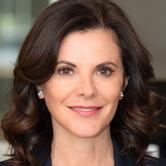
Patty Arvielo, Co-Founder and President
As a result of the company’s Latino Focus and New American Dream initiatives, New American Funding’s purchase lending in 2020 was 44.9 percent more than the industry percentage in lending to minorities, based on the most recently available data. Despite a year of upheaval due to the pandemic, New American Funding broke lending records in every month last year, helping more people buy a home or secure their financial future than ever before. Due to the growth of its business in 2020, New American Funding hired more than 2,600 new employees, more than doubling its workforce in one year.
In 2017, New American Funding pledged to increase Hispanic homeownership with $25 billion committed to new mortgages for Hispanic borrowers by 2024. That effort will continue throughout 2021 and beyond. The company will continue to offer competitive rates and a variety of loan programs, including Down Payment Assistance and Bond programs to help first-time home buyers meet down payment requirements, as well as help to pay closing costs. The company will also continue outreach efforts in minority communities to educate and encourage homeownership as a means to create wealth.
New American Funding considers itself a family. Through the company’s Diversity and Inclusion initiative, New American Funding embraces and values our differences and recognizes that they make the company stronger. The company is constantly working to increase diversity among its employees. As a result, the company’s efforts ensure that diverse voices are contributing to New American Funding’s continued success.
New American Funding’s Diversity and Inclusion efforts are company-wide, starting at the very top of the organization and reaching each of the company’s approximately 4,700 employees. The company embraces and encourages differences in age, color, disability, ethnicity, family or marital status, gender identity or expression, language, national origin, physical and mental ability, political affiliation, race, religion, sexual orientation, socio-economic status, veteran status, and other characteristics which make them unique.
New American Funding’s no-discrimination policy has led to a truly diverse workforce; approximately 60 percent of employees are female, approximately 45 percent are minorities, and approximately 37 percent are millennials.
One obstacle New American Funding will continue working to overcome is the decades of racial and economic inequality that have prevented minority communities from thriving. For far too long, members of minority communities have been denied the opportunity to become homeowners. Since its founding, New American Funding has fought to change that, and the company has no plans to slow down.




New York Life Headquarters: New York, New York Industry: Financial Services CEO: Ted Mathas
New York Life could not have achieved the success we enjoy today were it not for our richly diverse corporate culture. Rather than expect employees and agents to adapt themselves to a single way of doing business, everyone is encouraged to bring their own cultural and intellectual perspectives to the table.
Nor do we pursue a one-size-fits-all approach in the marketplace; our culturally sensitive outreach to customers has established New York Life as “The Company of the Community” in neighborhoods that reflect the changing face of America. Little wonder that we consider our commitment to diversity to be a fundamental strategic strength.
– Ted Mathas, CEO
We are living in turbulent times that require that we continue to respond to emerging needs quickly, providing support and guidance to our employees and leaders, as we continue our core programming. This requires balancing competing demands, prioritization, and heightened expectations. Diversity and inclusion have never been more important. The impact of the work we do is significant.
We continue our efforts of preparing women to take on new opportunities as they arise, including developing skills to run a P&L. Through the enhancement of existing professional development programs and leveraging our external partnerships and leadership opportunities within ERGs, we provide development opportunities, many of which reach beyond soft skills to the technical skills required to succeed in leadership roles. These prepared female leaders will be in the pool when C-suite and board opportunities become available.
Additionally, our Diversity & Inclusion team meets with department heads on a regular basis to discuss their workforce; year-to-date hiring, promotions, and attrition; upcoming opportunities; and progress against their D&I action plan. These efforts ensure that leaders are focused and accountable for preparing all talent.
For board recruiting, we have engaged a woman-owned recruiting firm that specializes in placing diverse candidates. Given this focus, they naturally have a variety of programs and approaches they have used to build their network of diverse candidates.

Keith McClain Vice President and Global Head of Compensation
His Credentials: Master’s degree, human resources management, Rutgers University; Bachelor’s degree, industrial and organizational psychology, University of Maryland
His Philosophy: Progress does not happen. Progress is made. Everything we are as a society and culture—all the good and all the bad—is the direct result of somebody deciding to act.
New York Life kicked off 2020 with our campaign, You Belong: Building a future where everyone belongs. We created a Social Justice Steering Committee to advance the company’s social and racial equity efforts. Our Social Justice Working Group assesses current initiatives and proposes practices to support employees and the broader community. We developed a new Coming Together program for small team sessions that discussed being color brave instead of color blind. The company designed and delivered manager and executive training on Leading During Uncertain Times to address COVID-19, as well as courageous conversation and inclusive leadership training. We also created 11 resource guides related to COVID-19 and social justice, and launched a new mentorship program for our Asian, Black, and Latino ERGs.
In 2021, we will continue to focus on supporting social justice. Our annual campaign, Social Justice in Action: Let’s talk about us, will provide a platform to help employees understand the importance of identity in intersectionality and what it’s like to walk in others’ shoes. Our Social Justice Steering Committee and Working Group will continue to implement initiatives to drive meaningful progress. We plan to continue our Coming Together courageous conversation series, and training and support for employees and managers. We will also expand our mentorship program and implement the next phase of our unconscious bias training program.



RBC Capital Markets
Headquarters: Toronto, Canada
Industry: Investment Bank
CEO: Derek Neldner
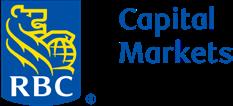
Now is a time where we must come together as a community to support each other, foster greater empathy and understanding, and show leadership in driving lasting change. I encourage you to check in on people who may be struggling, to provide your support and solidarity. I also encourage you to take action by speaking up and calling out instances of injustice when you see them and by championing inclusion and respect. It is important for us to have open, candid conversations—to listen, share perspectives, and understand the experiences of others. Together, we can and must make a difference.
– Derek Neldner, CEO

Sandye Taylor Global Head of Diversity & Inclusion
Her Credentials: JD, University of Maryland Francis King Carey School of Law; Bachelor’s degree, University of Maryland College Park
Her Philosophy: Stay solutions oriented. Create practical solutions that will be lasting, touch multiple areas of the business, bring valuable information to the entire organization, and most importantly, always stay focused on driving meaningful change.
RBC Capital Markets CEO Derek Neldner released the company’s first Global Diversity and Inclusion Blueprint in 2020, outlining strategic priorities and specific actions that would be taken over the course of the year to improve assessing and encouraging diversity and inclusion at work. The blueprint included a company-wide survey, the establishment of a Diversity Leadership Council, the introduction of KPIs that leadership would use to measure progress, and mandated diverse hiring practices. Additionally, the company committed to improving representation from Black, Indigenous, and People of Color. This included a $100 million program to be distributed over five years in small business loans to Black entrepreneurs and investing $50 million through RBC Future Launch to create pathways to prosperity for 25,000 BIPOC youth.
RBC has three goals for diversity, inclusion, and equity in 2021, which the company is driving from an enterprise level: enabling equitable opportunities by removing barriers; fostering and strengthening an inclusive culture; and driving systemic change through partnerships and transparency. The organization has committed to driving equity representation at titled officer levels, enabling an inclusive culture to help drive innovation and representation, and becoming recognized as a thought leader on the subject of diversity and inclusion.
RBC is driven by five core values: client first; collaboration; accountability; integrity; and diversity & inclusion. D&I being one of RBC’s key values means it is placed front and center in business discussions, and is a key pillar in our organizational structure. This is shown through the resources allocated to D&I initiatives, the senior leadership we have producing content focused on D&I initiatives, and the frequent communications we have around D&I with our stakeholders, both internally and externally.
It is RBC Capital Markets’ philosophy that our organization’s diversity and inclusion initiatives are a shared responsibility for each member of the organization. This means that we are communicating with employees about the initiatives and their progress from their first interview as a prospective employee and then, through regular emails and direct communications once they are on the team. With this in mind, we also know a dedicated D&I team is crucial to keep our many initiatives running. Across the larger Royal Bank of Canada organization, there are 15 full-time staff dedicated to D&I issues.
We are proud of the progress we have already made toward boardroom gender parity, with women making up 47 percent of our Board of Directors. To continue toward true gender parity among senior leadership, we have several specific strategies in place that we work on with our Human Resources team to elevate both the level of talent and representation within RBC.




SSephora Headquarters: San Francisco, California Industry: Prestige Beauty Retail CEO: Jean-Andre Rougeot
Sephora believes in championing all beauty, living with courage, and standing fearlessly together to celebrate our differences.
We will never stop building a community where diversity is expected, self-expression is honored, all are welcomed, and you are included.
– Sephora Manifesto
ephora’s diversity and inclusion mission is simple: championing all beauty fearlessly and building inclusive environments for our employees, consumers, and communities. In 2020, Sephora established its holistic Diversity and Inclusion Heart Journey strategy, which rests on these three key pillars:
1. Employees: includes expanding inclusive, fair, and equitable recruitment, retention, development, advancement, and rewards practices. For instance, Sephora has created an Accessibility Program to hire talent with disabilities across its five distribution centers. The retailer also launched comprehensive Unconscious Bias training and maintains fifteen employee resource groups.
2. Consumers: focuses on creating a welcoming and inclusive shopping experience and mitigating racially biased experiences and unfair treatment for shoppers. In January, Sephora released a report on the findings of the first-ever large-scale U.S. study on Racial Bias in Retail. To learn more about the study’s findings and resulting action plans, please visit: www.sephora.com/diversityand-inclusion
3. Communities: encompasses the charities, brands, and suppliers partnering with Sephora to ensure their Giving, Merchandising, and Supplier Diversity efforts are inclusive and representative of the people we serve. In 2020, Sephora was the first major retailer to take the 15 Percent Pledge and commit to doubling its assortment of Black-owned brands by the end of 2021.
Sephora’s D&I Heart Journey also focuses on increasing the representation and inclusion of six diversity groups: people of color, women, people with disabilities, working parents, LGBTQIA+, Millennials, and 50+.

George-Axelle Broussillon Matschinga Vice President of Diversity & Inclusion
Her Credentials: Master in Public Administration, Harvard University; Master’s degree in Management of people and organizations, ESCP Europe Business School; Master in Human Resources, Communication and Negotiation and Bachelor in Corporate Communications and Advertising, CELSA-Sorbonne University; Bachelor in Sociology and Bachelor in Philosophy, Paris Nanterre University.
Her Philosophy: What gets measured gets done.
In 2020, Sephora debuted its “We Belong to Something Beautiful” campaign—an articulation of Sephora’s values and commitment to diversity, equity, and inclusion. Our work became all the more salient, when calls for racial justice took hold, and George-Axelle was instrumental in answering them.
She conducted, and leveraged insights from, listening sessions with more than 400 of our Black/African American employees, and designed and launched Sephora D&I Heart Journey, a holistic, company-wide Diversity & Inclusion strategy with a simple mission: championing all beauty fearlessly and building inclusive environments for our employees, consumers, and communities.
George-Axelle was also instrumental in conducting Sephora’s first national research study on racial bias in retail, publicly released in 2021. She played a critical role in helping to shape the actions plans that resulted from the study. Under her leadership, Sephora will continue to reinforce its D&I goal of being a place where everyone belongs via its workforce, leadership, shopping experience, and product assortment. Existing commitments like the 15 Percent Pledge will be brought to life through programs like Sephora’s Accelerate brand incubator.



Walmart Headquarters: Bentonville, Arkansas
Industry: Retail CEO: Doug McMillon
Listening is a critical first step, but it is not sufficient on its own. We must follow up our listening with a commitment to learn and then to lead. It’s only when we are willing to understand another point of view, allow that to change our thinking, and then take action that we’ll continue to make progress. If this year has taught me anything, it’s that none of us knows what tomorrow will bring. What I do know is that if we’re all committed to listen, learn, and lead, there’s hope that tomorrow will be a little more inclusive and equitable than today.
– Ben Hasan, SVP, Chief Culture, Diversity, Equity & Inclusion Officer

Richard Mayfield EVP, Global Sourcing & Regional CEO - Walmex & Canada
His Credentials: BA & MA, economics, Cambridge University; ACA
His Philosophy: Valuing people for who they are and for the unique perspectives and capabilities they bring matters deeply to me. I am passionate about creating fair and equal access to opportunity and I know that our business is more innovative, agile and successful when our diverse associates feel a sense of belonging and can reach their full potential.
In 2020, our team established the following Vision, Objective, and Priorities for the President’s Inclusion Council:
• Vision: At Walmart, we value our differences and believe in including everyone.
• Purpose: Lead inclusion globally, creating a culture where diversity is essential and everyone is encouraged to be themselves.
• 3 Priorities: Build an Inclusive Walmart; Build Inclusive and Equitable People Processes across the Associate Life Cycle; Drive a Culture of Ownership, Accountability, and Engagement.
We committed $100 million (over the next five years) to create a center on racial justice, established 4 Shared Value Networks to identify issues Walmart can help address, built a comprehensive program to drive learning and awareness around inclusive leadership, took action to improve diversity in recruitment and hiring, increased transparency of diversity data and measurement, increased accessibility for disabled customers and associates, developed SMART action plans to advance diversity, equity, and inclusion, and mandated that corporate officers attend a two-day Racial Equity training session.
In 2021, we expect to see meaningful progress toward our goal of achieving a diverse and inclusive workforce that reflects our communities. We will be working to achieve continuous improvement in inclusion and equity as measured by our Associate Engagement Survey. We also expect to make significant progress in our drive for awareness and learning, as measured by completion of mandatory training and usage levels of training on Inclusive Leadership.
We’re in the business of welcoming—our associates spend a lot of time supporting and serving one another, as well as our customers and communities. That’s why inclusion is a cornerstone of Walmart’s business, and we are a better, more resilient company because of it. We focus on helping people save money so that they can live better. For us, living better also applies to fostering an inclusive culture and equitable workplace, so that every associate has the opportunity to reach his or her full potential.
As of July 2020, our U.S. workforce of more than 1.4 million associates included 20.7 percent Black or African American associates, 16.4 percent LatinX associates, 4.9 percent Asian American or Pacific Islander associates, and 1.1 percent Native American or Alaskan Native associates. Women represented 55.1 percent of our global workforce, which included 44.8 percent of global management associates and 30.2 percent of global officers.
By fostering a workplace culture where everyone is included, everyone wins. Associates are happier, perform at their best, and in turn, provide better service to our customers and members. The mission of our Global Office of Culture, Diversity, Equity & Inclusion is to create an inclusive culture where all associates are engaged to deliver on our purpose of saving people money so they can live better.
To drive change inside and outside our company, we announced in June 2020 that Walmart would develop strategies and invest resources to increase fairness, equity, and justice, with specific attention paid to America’s health care, financial, education, and criminal justice systems.




Wayfair
Headquarters: Boston, Massachusetts Industry: e-Commerce
CEO: Niraj Shah
We can reconfirm our belief that racism in any form (explicit or implicit) is unacceptable in our community, both at Wayfair and in the communities in which we live. We need to keep saying this, more loudly and even more often. And, we must confront, and change, any examples we find. While I believe that we have always tried to do this, I think the early success of our internal efforts from the last year, and the plans of things to come, show that we can and should do more.
But the most important thing for all of us to do today is support each other, take care of each other. This is true here at our Wayfair community and this is also true in our other communities, with our families and friends, places of worship, towns and cities. Each of us can be there for each other, listening and learning, and it will make the world a tiny bit better.
– Niraj Shah, CEO
At Wayfair, there are no corner offices. In fact, there are no offices at all. We support an open, transparent workplace where leaders mentor the more than 16,700 bright talents that sit among them—and vice versa.
The Diversity, Equity and Inclusion (DEI) team serves as Wayfair’s internal compass that promotes a global community, ensures an inclusive culture, and grows market penetration through innovation, which can only be provided through a sense of belonging across a diverse workforce.
We use data to understand the current state of DEI at Wayfair, set goals for improvement, and track our progress over time. Looking at our representation data, we see that our corporate, tech, and leadership populations are not as diverse as we would like them to be. This knowledge informs our DEI strategy and initiatives. Our goal is to move the needle on representation as a result of these initiatives. We will achieve this by doing the following:
• Leveraging qualitative and quantitative data to better assess people patterns
• Identifying intervention points throughout the employee lifecycle
• Highlighting opportunities within physical and virtual spaces to enhance a sense of belonging
• Striving to delight the customer by leveraging a workforce that reflects them

KeyAnna Schmiedl Global Head of Culture & Inclusion
Her Credentials: BS, human services & MBA, human resources, Fitchburg State University
Her Philosophy: We know that our unique perspectives make us stronger, smarter, and well positioned for success. We value and rely on the collective voices of our community to help us build a better Wayfair—and world. Every voice, every perspective matters. Embedding DEI principles into Wayfair practices allows the organization to take full advantage of the ideas, suggestions, and feedback unique to our diverse and talented workforce.
In just 18 months, KeyAnna has established the DEI function at Wayfair, driven our focus on data transparency, rewritten our core People Principles, structured our ERGs, and placed DEI at the forefront of everything we do.
In 2020, the DEI team spearheaded the launch of a company-wide DEI Council to build and sustain an inclusive culture, and co-created new DEI training for recruiters to increase diversity in candidate pools. The team elevated Wayfair’s DEI tracking and measurement, focusing on data transparency and leveraging data to understand the current state of DEI and inform training. And partnering with Corporate Social Responsibility (CSR), the team supported the rollout of a program that doubled employee donation matching and a day of service, leading to more than $900,000 in donations to organizations that support ending racism, hatred, and violence.
In 2021, through cross-functional partnerships, the DEI team will continue to create strategies and identify initiatives to increase diversity in the talent we recruit, develop, and promote. These efforts will foster an inclusive environment that encourages all employees to bring their authentic selves to the workplace, propelling the innovative potential of the organization. Using qualitative and quantitative analysis to identify levers to create equitable outcomes, Wayfair will strategically build a best-in-class culture.




The 1st Annual Latino Leaders Worth Watching™ Awards PDJ
For more than two decades Profiles in Diversity Journal has honored outstanding individuals who have blazed new trails, welcomed challenges, mentored others, advanced diversity and inclusion in the workplace and the community, and excelled in their chosen fields. Now, PDJ is honoring Latino Leaders with our first-ever Latinos Leaders Worth Watching Awards.
The 38 profiles that appear in this issue recognize and celebrate the hard work and impressive achievements of these Latinos Leaders. Each award recipient has also provided us with the answers to some interesting questions and an essay that will give you, our readers, a chance to get to know these multitalented, multilingual, and trailblazing individuals a little better.
Welcome to PDJ’s first annual Latinos Leaders Worth Watching Awards.






















Education: JD, Harvard Law School; AB, Harvard College
Company Name: Akin Gump Strauss Hauer & Feld LLP
Industry: Law
Company CEO: Kim Koopersmith, Chairperson
Company Headquarters Location: N/A
Number of Employees: 1750+
Your Location (if different from above): New York, New York
Words you live by: “Remember where you came from.” The words may be cliché, but they remind me (1) to work hard, (2) of my parents who sacrificed so much to make my current life possible, and (3) of how much upward change can happen in just one generation.
Who is your personal hero? My mother
What book are you reading? Inventing Latinos: A New Story of American Racism by Laura E. Gomez; Harry Potter and the Deathly Hallows by J.K. Rowling (with my son)
What was your first job: As a freshman in high school, I worked for a solo legal practitioner.
Favorite charity: The Bronx Defenders, a holistic public defense firm that serves the South Bronx Interests: Dancing; spending time with my family Family: Allon (husband); Nicolas (son); Sofia (daughter)
Like many children of immigrants, I learned to navigate two worlds early on—one foot in one culture, one foot in the other, sometimes hopping from side to side in one day. “ ”
Like many children of immigrants, I learned to navigate two worlds early on—one foot in one culture, one foot in the other, sometimes hopping from side to side in one day. I remember translating at stores, doctor’s offices, and at school, from a very young age. I filled out forms and made phone calls on my parents’ behalf. Without knowing it, these experiences were my first foray into being an advocate: using a skill, in this case the English language, to obtain
something for someone who could not get it for him- or herself. While other experiences went into the stew that led me to law school and, finally, to a thirteen-year career as a “BigLaw” partner, I still think of those childhood acts as my first lawyering moments.
I am a litigation partner who focuses on white collar and regulatory investigations on behalf of boards, companies, and universities. The personal and professional satisfaction I get from

my challenging and demanding job is considerable. But even greater is the satisfaction I get from seeing an increased number of Latinx candidates navigating the BigLaw recruiting season (delayed this year due to the pandemic). They give me hope that, soon, Latinx BigLaw partners will no longer be unicorns. I know that some of these candidates also navigated different worlds from an early age, and that those skills will ultimately lead to their success in the legal field.
Rubén H. Muñoz
Partner-in-Charge, Philadelphia Office

Education: Juris Doctor, University of Pennsylvania Law School; Certificate, business and public policy, The Wharton School, University of Pennsylvania; Master of Science, mechanical engineering and Bachelor of Science, chemical engineering, Louisiana State University
Company Name: Akin Gump Strauss Hauer & Feld LLP
Industry: Law
Company CEO: Kim Koopersmith, Chairperson
Company Headquarters Location: N/A
Number of Employees: 1750+
Your Location (if different from above): Philadelphia, Pennsylvania
Words you live by: In the words of Nelson Mandela: “A leader is like a shepherd [who] stays behind the flock, letting the most nimble go out ahead, whereupon the others follow, not realizing that all along they are being directed from behind.”
Who is your personal hero? My parents
What book are you reading? Monopoly on Wheels: Henry Ford and the Selden Automobile Patent by William Greenleaf
What was your first job: Research Engineer at Ford Motor Company’s Scientific Research Lab
Favorite charity: Support Center for Child Advocates
Interests: Traveling the world with my wife and two daughters; the gym; golf; and fast cars
Family: Wife Ania; daughters Emilia and Klara
My career path has been anything but a straight line. I was born and raised in Honduras, moved to the Deep South for college, worked in the Midwest—designing engines—for one of Detroit’s Big Three, came to the Northeast for law school, and have remained here litigating intellectual property disputes for well over a decade.
I think I knew from a young age that I wanted to be a lawyer. It probably had something to do with my dad—himself a lawyer. He never suggested it as a career, but his quiet example must have influenced me greatly. Of course, I had no idea that things would work out exactly the way they did. Right after high school, my family and I traveled to Louisiana for vacation. In my mind, after two short weeks, I would head back home to start law school. But at my parents’ suggestion, I stayed behind for what I thought would be
a one-semester refresher on my elementary-school English.
That one semester gave me a taste of life in the United States and the ensuing endless possibilities. It quickly became clear that, as a foreign student, a science career was my best choice to remain in the United States post-graduation. My degree choices were therefore pragmatic. I earned degrees in chemical and mechanical engineering. After publishing and presenting my graduate research, which focused on combustion, my adviser got a call from Ford Motor Company engineers interested in my work. They invited me to Dearborn for interviews and I was offered not only a job—that I accepted on the spot—but also permanent residence.
My nearly six years at Ford were an engineer’s dream. At the time, Ford owned a stable of brands worldwide, and I worked shoulder to shoulder with engineers from around the world.


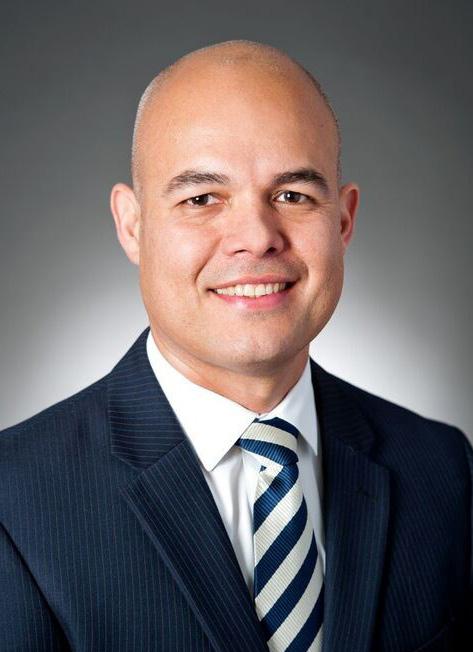
I experienced firsthand American ingenuity, European precision, and Japanese dedication to perfection— learning lessons along the way that I carry with me to this day. But despite an incredibly rewarding career at Ford, my internal compass kept pointing me toward the practice of law.
In 2004, I left my engineering job and moved to Philadelphia for law school. I have been litigating IP cases since, for some of the biggest companies in the world. The practice of law, especially at Akin Gump, has been everything I had hoped for, and then some. Not only have I represented high-profile clients in IP matters, but also the most vulnerable, including survivors and families of victims of extrajudicial killings in Latin America.
If I were advising my young self, I would say: trust your internal compass, do not be afraid to forge a path never before traveled, and help others along the way.


Education: Master of Business Administration, operations management, St. Edwards University; Bachelor of Science, industrial distribution, Texas A&M University
Company Name: Advanced Micro Devices
Industry: Semiconductor
Company CEO: Lisa Su
Company Headquarters Location: Santa Clara, California
Number of Employees: 12,600
Your Location (if different from above): Austin, Texas
Words you live by: There are many paths to success but all require hard work and determination.
Who is your personal hero? My parents; they have always been my source of inspiration and great examples of hard work.
What book are you reading? Greenlights by Matthew McConaughey
What was your first job: Forecast Analyst at Motorola Inc.
Favorite charity: Mobile Loaves and Fishes
Interests: Spending time with family, traveling, and listening to live music
Family: Three children: a son, Carson (21); a daughter, Chloe (18); and a daughter, Claire (14)
Open-mindedness is by far the trait that has been essential to my success. Throughout my career, I have embraced many different roles within each company I have been a part of and used each of them as an opportunity to learn and grow. While the roles have required me to step out of my comfort zone, each allowed me to learn, grow, and develop new skills. My willingness to embrace new and challenging assignments allowed my career path to evolve beyond any predetermined roadmap or playbook I could have imagined.
My professional career path has been a nontraditional route for sure, but has advanced my overall development and given me the perspective that many paths lead to success. As I consider my overall experiences, I believe each provided an opportunity to navigate large matrix organizations, learning to connect concepts and build a network of resourceful contacts.
I started my undergraduate career focused on engineering and technology, and graduated with a bachelor’s degree in industrial engineering from Texas A&M’s College of Engineering in 1998. I joined the workforce in an entry-level role focused on demand planning and rationalization with Motorola, Inc. After approximately one year, the finance controller approached me, and I joined his team as a financial analyst supporting a key business unit. That decision changed my career trajectory. Over the next eight years at Motorola (later Freescale), I rotated in and out of five critical finance support roles, including supply chain, IT, corporate accounting, and external reporting.
My open-mindedness and willingness to tackle roles beyond my area of expertise compelled me to rapidly develop new technical, business, and leadership skills. This learning style and my ability to adapt had a tremendous impact, unleashing my potential

and confidence to continue to take on new challenges and opportunities that may have never been on my direct career roadmap.
In May 2011, I joined AMD in one of its largest business units as a frontline manager, which allowed me to understand the business and learn how to navigate the new environment. I have continued with the same mindset of learning, growing, and developing without boundaries throughout my time at AMD. It has now been almost ten years, and I have held five different roles within the company, which has allowed me to continue the growth and development of my skills, style, and brand. My promotion to corporate vice president of finance in July 2020 defined a moment of success and demonstrated that my career path has required the utmost faith in myself and the ability to see beyond today’s role and challenges.
Chief Architect, Gaming Solutions and Marketing

Education: High School; some college
Company Name: Advanced Micro Devices (AMD)
Industry: High Tech
Company CEO: Lisa Su
Company Headquarters Location: Santa Clara, California
Number of Employees: 12,600
Your Location (if different from above): Miami, Florida
Words you live by: Focus on what matters. Adapt and overcome. The secret to a happy life is having low expectations.
Who is your personal hero? My father
What book are you reading? Create the Future & The Innovation Handbook by
What was your first job? Retail associate at McFrugal’s
Favorite charity: FIRST Robotics
Interests: PC games, boating, and fishing
Family: Married to wife, Lucy, and we have 2
our
Growing up, I was a selfproclaimed nerd with a passion for building my own PCs. My first opportunity to turn this passion into a career came to me when I was just 16 years old. Through a mutual friend at the time, I met three other “nerds” just like me who were starting a company by the name of Alienware. We had many common traits, including that we all came from very humble backgrounds and we were all the sons of Cuban immigrant parents. We had an incredible time building the business, but it wasn’t without many challenges. One of those challenges was the fact that I was so young. In the struggle to succeed as a small and unfunded startup, people I’d interact with often didn’t take me seriously, partly due to my very young age. While initially frustrating, I eventually realized and accepted that this was an opportunity for me. Their initially low expectations gave me an
opportunity to impress them, and in doing so, gain their confidence and drive results.
In 2006, when I was just 25 years of age, we sold the company to Dell, and I was suddenly propelled from a company with 1,000 employees into the world of a multinational global enterprise with 55,000 employees. It was an intimidating experience that filled me with insecurity—how would I perform compared to these highly educated and experienced professionals than which, on-average, I was a decade younger? How would they accept a predominantly Latino-staffed company, led by mostly undereducated entrepreneurs, integrating into their culture?
Thankfully, those concerns never materialized. What mattered at this new company were the same things that had always mattered at Alienware—what you did, how you did it, and the results you generated. We continued to


focus on growing our business and making our success hard to ignore. Today, Alienware is the premier PC gaming brand in the world. Eight months into taking on a new role with a new employer, AMD, COVID hit the United States and we were all sent home and business travel was shut down. We have yet to go into the office or travel to meet one another, yet I’ve nearly doubled the size of my team. Most of these employees I have never met in person, yet we are thriving together and achieving many ambitious goals. I hope some of the silver lining of this whole experience we are all going through is that it leads to more inclusive workplaces. With personal differences less evident in this new virtual workplace operating model of talking heads (and sometimes cats), we can focus less on distractions and more on what truly matters.

Corporate Vice President, Strategic Accounts

Education: BSEE, Arizona State University
Company Name: Advanced Micro Devices
Industry: Semiconductor
Company CEO: Lisa Su
Company Headquarters Location: Santa Clara, California
Number of Employees: 12,600
Your Location (if different from above): Scottsdale, Arizona
Words you live by: Why put off for tomorrow what you can do today?
Who is your personal hero? My Father, Johnny J. Nunez Jr.
What book are you reading? Target Alex Cross by James Patterson
What was your first job: Picking table grapes in the Arizona desert
Favorite charity: Goodwill
Interests: Downhill skiing, golf and off-roading
Surround yourself with your replacement(s) ...
I was given this advice very early in my career by a very wise sales leader at Motorola Semiconductor, and I have heeded his advice and passed it on many, many times to my teams and peers.
Never fear being replaced …
As counterintuitive as it may seem, never fear being replaced, but rather look at those you compete with from the perspective that they will only drive you and challenge you to be better.
Gain buy-in …
With the belief that success is driven from within, a sales leader and his or her team must buy-in
and execute accordingly. The best way to inspire this buy-in is to provide the best members of your team the opportunity to achieve their personal goals, while achieving the goals set for the team. So, always hire the best, and teach them everything you can, so they become even better. Also, let them know you believe in their success, and therefore, the team’s success.
Hire the best …
I have had the privilege of hiring and mentoring many high-technology sales professionals here at AMD. I have also hired more than a few right out of university. Toward the end of my tenure at Motorola Semiconductor I was given the opportunity to lead their then very successful Sales Engineering Recruiting Program

(SERP). Motorola believed that hiring the best engineering graduates with the most potential would pay off for the company in the long run. I was hired into this program after graduating from Arizona State University with my BSEE, as were many others who became semiconductor industry top sales and business executives.
Additionally, this very wise (and accomplished) leader drilled into me that achieving success is rarely easy. Keeping this in mind when assembling your teams, from new grads to established industry leaders, lends itself to a self-fulfilling prophecy. The best-in-class team you have surrounded yourself with will help exceed even your loftiest goals for success.
Director HR Business Partner
Education: Bachelor of Business Administration, human resource management, The University of Texas at San Antonio
Company Name: Advanced Micro Devices (AMD)
Industry: High Tech
Company CEO: Lisa Su
Company Headquarters Location: Santa Clara, California
Number of Employees: 12,600
Your Location (if different from above): Austin, Texas
Words you live by: Be accountable, strengthen your faith daily, be good to people, give back, and see the light in others that they may not be able to see in themselves. Who is your personal hero? My sister
What book are you reading? The last book I read is now my favorite: Untamed by Glennon Doyle
What was your first job? Private caretaker for an elderly woman with advanced Alzheimer’s disease
Favorite charity: Dress for Success (Board member)
Interests: Movies, live concerts, and cooking
Family: Husband, Lawrence; sons: Andrew (11 yrs) and Jason (9 yrs); and our Labradoodle, Cutie (3 yrs)

Values can be learned, formed over time, or emulated from people you respect. Regardless of what your values are, they help define you, provide a foundation on which to build your persona, and guide you, as you navigate life’s twists and turns.
When interviewing applicants for jobs at AMD, I like to ask them about the values they hold most dear and I share with them my core value—learning. My most valuable learning has always come through failure, and I would not be here today without experiencing multiple career and personal life challenges. Whether it was being scared to take on a new role, losing a job that was not a good fit for me, or being afraid to admit my sons may need special education, I am so much stronger and wiser because of each challenge and remain grateful for these invaluable learning experiences.
What I learned from failing is that you have the power to rise up and rise higher. I have lived and fully embrace my favorite quote: “A person often meets his destiny on the road he took to avoid it.” – Jean de La Fontaine. If you keep running into the same frustrating situation and nothing is changing, perhaps there is a lesson to learn right in front of you. And if you are scared, good, that means you are ready! Act on it and rise higher!
I no longer fear failure, I lean into that which scares me because I know that I have a community around me that will help support me along the way. When I do have down or sad moments, I try to help someone else to gain perspective. It is our duty to lift up others. When we mentor others, when we serve our community or volunteer our time altruistically, the intrinsic personal value and perspec-
tive gained is far greater and longer lasting than any monetary reward would be.
I wish I had known early in my career that vulnerability is okay. Taking risks and learning from them is gold. And when you stop trying to prove yourself and are comfortable in your own skin, that’s when the magic really happens! I challenge other Latinos to answer the call to mentor—lean into your fears and be a light and guide to others. By doing so, we help shape our teams, our culture, and our community, and pass on our core values that others will carry forward as our next generation of diverse leaders.
I am so thankful to AMD for nominating me for this award, to Profiles in Diversity Journal for spotlighting the Latino community, and to my family and friends for always supporting me.



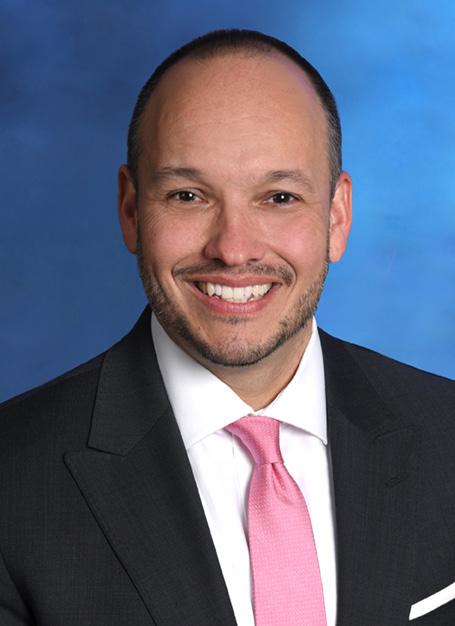
Partner, Ontario Office Managing Partner
Education: JD, University of California, Hastings College of the Law; BS, political science, University of California, San Diego
Company Name: Best Best & Krieger LLP
Industry: Law
Company CEO: Managing Partner Eric Garner
Company Headquarters Location: N/A
Number of Employees: 400
Your Location (if different from above): Ontario, California
Words you live by: “You will never do anything in this world without courage. It is the greatest quality of the mind next to honor.” –Aristotle
Who is your personal hero? My dad, Ray Duran (deceased 2002). Born to immigrant parents, and unable to complete schooling beyond middle school, he still built a solid working-class life, bought a house, raised six kids, sent me to college and law school, and left a legacy of the value of hard work and caring for others in a quiet and unassuming way.
What book are you reading? Meditations by Marcus Aurelius
What was your first job: Box boy/stocker at the corner convenience store in El Monte, California (age 14)
Favorite charity: Coro Southern California
Interests: Cooking, Southern California hiking, and learning to play the piano
Family: Married to my high school sweetheart, Cynthia Gandara; two adult sons: Diego (University of Oregon, Class of 2017) and Nicolas (Columbia University, Class of 2021)
From a very early age, I was certain I would be a medical doctor. I was one of those kids who liked giving a blood sample (fascinated by the vial filling up with that luxurious shade of deep red), and the idealist in me wanted to find a cure for Prader-Willi Syndrome, the genetic disorder with which my twin sister, Regina, was born. Accordingly, I started at the University of California–San Diego as a pre-med major. Two terms of regular all-nighters to prepare for and stress over science midterms, juxtaposed against the blast I was having in student government and my humanities classes, convinced me that a political science major with a path to law school might be better for my health and sanity.
I was a Coro Fellow in Public Affairs after college, which was a natural extension of the politics and policy-based
fun I had had at UCSD. As a young father starting law school, I wanted to use my legal education to improve cities and ensure my kids could grow up in a strong and healthy community. Becoming a city attorney was the perfect blend of my legal training and my passion for policy and politics. Instead of becoming a politician (as my mother had always hoped), I would instead work for elected community leaders.
It’s an axiom that all politics is local, and our day-to-day lives are affected more by city hall than almost anything that happens in Sacramento or Washington, DC. Whether it’s an after-school program for kids, the development of affordable housing, or planning for transportation and jobs, local governments make decisions and provide programs that help communities and people thrive.
That is why I’m so blessed to be the city attorney for the cities of Fontana and Ontario. These two local governments serve diverse communities of almost 400,000 people collectively. Whether I’m advising on new commercial and retail development, housing production, or citizens’ academies, I love helping council members and their staffs serve their communities and achieve their goals within the bounds of the law. As vice chair of the Board of Trustees for the California Bar, I work on issues affecting diversity in the legal profession and the protection of the public. Most important, though, I hope I am teaching my sons that even “certainties,” like becoming a doctor, can evolve and change in ways that make life fulfilling and fun.


Education: JD, Duke University School of Law; BA, Phi Eta Sigma Honor Society, Duke University
Company Name: Dechert LLP
Industry: Law
Company CEO: Henry N. Nassau
Company Headquarters Location: Philadelphia, Pennsylvania & New York, New York
Number of Employees: Approximately 2,000
Your Location (if different from above): New York, New York
Words you live by: No matter the situation in which you find yourself, a “glass half full” mentality will help get you through it.
Who is your personal hero? I have had the good fortune of learning from my parents, who have inspired me to be honest, always positive, magnanimous, hard-working, and aspirational. They engrained in me the notion that anything is possible as long as I don’t give up and do my best.
What book are you reading? The Language Instinct by Steven Pinker—a fascinating look at language and the brain
What was your first job: I had a summer job as a computer programmer at Bell Northern Research in Durham, North Carolina. It paid $9 an hour.
Favorite charity: Israeli Tennis and Education Centers, the largest social service agency in Israel that works to enhance the social, psychological, and physical development of Israeli children through the medium of tennis
Interests: Traveling with my family, competitive tennis, and skiing
Family: My wife, Gabrielle; daughters, Danielle (22) and Chloe (20); and son, Jack (16)
For many years now, I’ve worked to attract more diverse individuals to the legal profession. Much more still needs to be done, of course, but we have seen change, and we can point to progress. It is uplifting to see folks so willing to identify themselves now as LGBTQ, for instance—by including a reference in a resume or bringing it up in an interview—and it’s equally satisfying to see law firms and other organizations becoming more inclusive as institutions.
In the legal profession, those involved in hiring have awakened to the importance of recruiting multifaceted individuals. At Dechert, we look for diverse, intelligent, open-minded people—candidates who are articulate and talented, but who can also communicate and connect with those around them. We operate in a service industry, serving clients located throughout the world. Having a group of people who can address problems from


different perspectives provides the greatest chance of crafting a creative solution. When a business is focused on providing advice, finding commonality with the people it represents is vital to building trust and gaining confidence.
Personally, it has always come naturally to me to search out touchpoints with others. I spent my teenage years in North Carolina, but I was born to Iraqi-Jewish parents in Rio de Janeiro and was brought up with Portuguese as my first language. That wasn’t the easiest of upbringings, but it’s given me enormous empathy. I can identify with those who weren’t born here, or who don’t speak English well, or feel they don’t fit in. I can relate to them because I know what that’s like. Yet I also consider myself fortunate because that cultural mélange has gifted me with so many ways to form connections with those around me. I reap the benefits every day. Our world is so integrated and our work at Dechert so international

that I’m frequently able to find a Brazilian connection, or some other touchpoint, that creates a bond, even if the work itself has nothing to do with Latin America.
Keeping these thoughts of cultural connectivity front of mind has been important during my experiences in the recruitment process. I have worked hard to eliminate bias and fight in the diversity corner in the hiring process wherever I worked—sitting on hiring committees, attending recruitment events, and screening potential hires. I have also worked to support diverse individuals in the long term—helping integrate newly hired partners, mentoring junior lawyers, and now, as a newly appointed diversity liaison partner in Dechert’s corporate practice, ensuring access to work assignments, training, mentoring, and supporting women and diverse associates. Having the opportunity to help folks adapt— and thrive—in new environments is enormously rewarding.
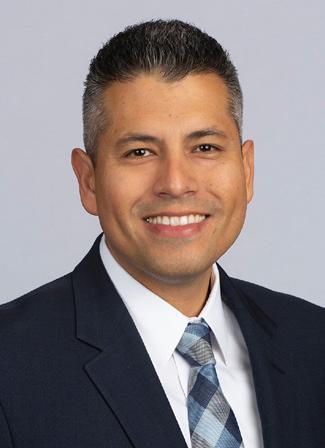
Vice President, Utility Distribution Operations

Education: MBA, Florida International University; BS, electrical engineering, Florida International University
Company Name: Entergy Corp.
Industry: Electric Utilities
Company CEO: Leo Denault
Company Headquarters Location: New Orleans, Louisiana
Number of Employees: 13,600
Words you live by: “A hundred years from now it will not matter what my bank account was, the sort of house I lived in, or the kind of car I drove. But the world may be different because I was important in the life of a child.” –Forest E. Witcraft
Who is your personal hero? My mother Ana, who raised me through tough financial situations, after we lost my father at a young age
What book are you reading? Fearless Success: Beyond High Performance by John Foley and Hug Your Haters by Jay Baer
What was your first job? Flea market sales rep
Favorite charity: Children International and our church
Interests: Reading, music (I play trombone and guitar), basketball, and spending time with family
Family: My wife Carol, who is my rock, and my lovely daughters, Cynthia and Samantha
I am truly honored to have been selected for this award, especially one for “Latino Leaders,” which is especially meaningful as a first generation immigrant and college student.
As I reflect on what it will take for future leaders and organizations to be successful, I feel we need to start by recognizing that there is always a greater purpose and meaning in the work we do, and that precise notion needs to drive our actions. As leaders, it goes beyond individual or business successes and means supporting your teams, making career aspirations come true for others, helping people grow, building inclusion and belonging, not being afraid of holding tough and meaningful conversations, and motivating people to be their very best. As a company, it means going beyond just producing economic value in the traditional sense, but also working toward a better tomorrow
and embracing the responsibility organizations have to help the communities they serve, continuing to put their customers first, and embracing society’s challenges and opportunities.
Our actions should be authentic—and not just because it makes business sense. We should be invested in mutual growth and committed to strengthening the fabric of trust. As Daymond John (CEO of FUBU and TV personality on ABC’s Shark Tank) recently posted on LinkedIn, “Supporting another person’s success will never ruin the chances of yours.” It is not a zero-sum game, and we need to believe in this principle. I have personally benefited from leaders who believed in me and a network of mentors who unselfishly shared their knowledge and support with me over the years—each with diverse backgrounds and leadership styles. Because of this, I welcome and look for opportunities to help

other individuals succeed both at and outside of work.
It is a great feeling to be with a company like Entergy that believes in the mission of helping others and aspires to give back through its admirable volunteerism and focus on diversity, inclusion, and belonging.
I feel I can do more to help people from all communities and ethnic backgrounds, and it’s that burning desire that fuels me. It is important for my family and I to give back to our community, and we are inspired to look for ways to positively impact other Latino families and small businesses in need. I am thankful and proud of this special recognition. I hope it helps raise the profile of Latino leaders across the globe and of our commitment to do well by doing good. I hope you are also inspired to take action and look for ways to support someone else’s success or to use it as fuel to continue doing so. That is a greater purpose worth pursuing.
Todd E. Garcia
Managing Principal–Boston, Corporate Secretary
Education: JD, University of New Hampshire Franklin Pierce School of Law; BS, MS, PhD, University of Rhode Island
Company Name: Fish & Richardson P.C.
Industry: Law
Company CEO: John C. Adkisson
Company Headquarters Location: Boston, Massachusetts
Number of Employees: 1,159
Words you live by: Loyalty unreturned is loyalty misplaced.
Who is your personal hero? My father
What book are you reading? None right now
What was your first job? Busboy and waiter
Favorite charity: Any having to do with treatment of rare diseases
Interests: Weightlifting, martial arts, and working out with my son
Family: Married for 22 years; three children, ages 19, 16, and 12

Someone told me long ago that if you have a career you love, it will pass in the blink of an eye, so I try to slow down and enjoy the ride because I deeply love what I do and want to enjoy every minute of it. “ ”
My interest in both science and the law started in elementary school. I remember participating in a program in fifth grade (it was called Legal Eagles or something like that), where we learned about the court system and the Constitution, and I was hooked. Then, in seventh grade, I got to use a professional-grade microscope for the first time and peered into another world—yep, definitely hooked. I went to college and ultimately pursued a PhD in microbiology. During my studies, patenting the human genome was a hot and controversial topic, and it was a topic that I found completely fascinating. I realized there was no better way to enjoy both the fields of science and law than by becoming a
patent attorney.
After earning my PhD, I was off to law school and a very special career path. And in this career and my firm I found my calling—protecting my clients’ intellectual property on the cutting edge of science.
Much of my patent prosecution and opinion work for clients is focused on developing patent portfolios that are the first, or among the first, in a particular scientific area. I use my scientific and legal expertise to protect clients’ innovations in immunology, cell and molecular biology, virology, bacteriology, biochemistry, and medical and diagnostic devices. Without patents, these potentially life-saving innovations will likely
never be commercialized and brought to people in need, so I feel honored every single day to be part of this very important work.
I was also fortunate to have trained under the best in the business. My mentors at the firm truly took an interest in me, encouraged me during difficult times, and made sure that I understood what it meant to be a good advocate for clients. I still work alongside many of them and am proud to call them my partners.
Someone told me long ago that if you have a career you love, it will pass in the blink of an eye, so I try to slow down and enjoy the ride because I deeply love what I do and want to enjoy every minute of it.


Allison Saunders Managing Partner, Los Angeles Office
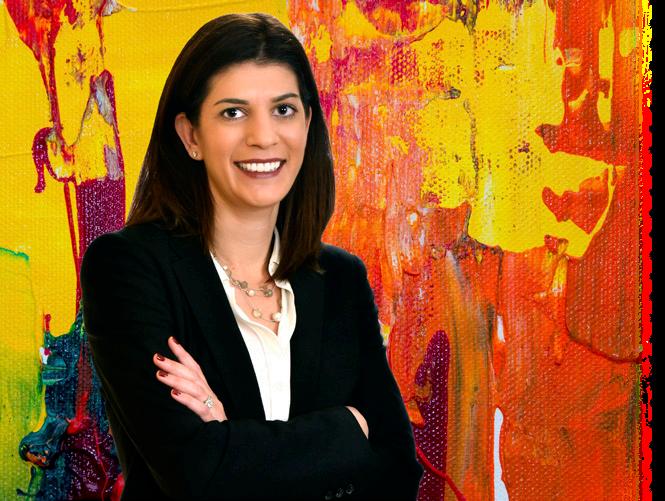
Education: JD, Chicago–Kent College of Law; BA, University of California, Los Angeles
Company Name: FordHarrison LLP
Industry: Law
Company CEO: Allen J. McKenna
Company Headquarters Location: Atlanta, Georgia
Number of Employees: 256
Your Location (if different from above): Los Angeles, California
Words you live by: I think there is nothing more important than being honest.
Who is your personal hero? Michelle Obama
What book are you reading? The Splendid and the Vile by Erik Larson
What was your first job? I worked at a frozen yogurt shop.
Favorite charity: St. Jude Children’s Research Hospital
Interests: Cooking, eating, traveling, reading
Family: My husband, daughter, three stepchildren, two dogs, and one cat
As a litigator who has always spent more time on the road and outside an office to perform my job, the pandemic was life changing in that it gave me some of my life back by allowing me to work remotely and by Zoom from the comfort of my own home. “ ”
In the 20 years I have worked in the legal profession, I have learned that this business is not kind to either women or people of color. The pandemic taught me the same thing. For one, it has had a disproportionate economic impact on all minorities, including Hispanics, who are often working in jobs that cannot be performed from home, may require travel on public transportation, and do not offer workers paid time off when they or others in their families fall ill. Similarly, the pandemic has
forced women to leave the workforce or sacrifice their career momentum to care for children who have no place to go when schools are closed. For many, this has been a major step backward. Surprisingly though, the pandemic has had a positive impact for some of us who prior to it spent hours of our day commuting from one place to another, forcing us to spend less and less time with our families. As a litigator who has always spent more time on the road and outside an office to perform my job, the pandemic was
life changing in that it gave me some of my life back by allowing me to work remotely and by Zoom from the comfort of my own home.
For some of us, it has changed how we think about how work can be done and why it should be done differently. In the coming years, I believe that the world will continue to embrace the ability to perform many of our day-today functions remotely. Once schools reopen, I think this change will also result in many of us experiencing better work-life balance.


Education: JD, Stanford Law School; AB with honors, Duke University
Company Name: Frantz Ward LLP
Industry: Law
Company CEO: Christopher G. Keim, Esq.
Company Headquarters Location: Cleveland, Ohio
Number of Employees: 110
Words you live by: Work together as a team. Listen. Give everything your best.
Who is your personal hero? My Father, Al Sanchez
What book are you reading? None presently; just authored a chapter for an ABA book on Construction Ins.
What was your first job? Newspaper delivery
Favorite charity: The Cleveland Leadership Center and The Centers for Families and Children
Interests: Outside activities, including gardening, grilling, boot camp, and drinking red wine

New leaders cannot be afraid to be themselves. There is no need for them to conform or lose their individuality or identity—the very things that have driven their success so far. “ ”
We can reach out to up-andcoming leaders in the community, spend time with them and mentor them. We can assist with the development of technical skills, but more important, we can make sure they understand and appreciate what has contributed to our own success.
For me, it’s authenticity and transparency. New leaders cannot be afraid to be themselves. There is no need for them to conform or lose their individuality or identity—the very things that have driven their success so far.
We can offer to make introductions, share our success
stories, and equally important, share our failures. No one can lead effectively if he or she is constrained by fear of failure. We can and should be there for these new leaders, both in times of great stress and in times of great success.




My career, and much of my life, has been defined by movement and change. Being flexible and adaptable, along with maintaining a positive attitude, has helped me discover and take advantage of new opportunities to grow professionally.
Vice President, Single-Family Credit Risk Transfer Capital Markets

Education: MBA, finance, University of Maryland–Robert H. Smith School of Business; BS, business and finance, University of West Florida
Company Name: Freddie Mac
Industry: Financial services
Company CEO: Michael Hutchins, President
Company Headquarters Location: McLean, Virginia
Number of Employees: Approximately 6,900
Words you live by: It’s all about attitude.
Who is your personal hero? N/A
What book are you reading? Leading with Questions: How Leaders Find the Right Solutions by Knowing What to Ask by Michael J. Marquardt
What was your first job? My first job out of college was as a loan officer. Before that, I was a tennis coach.
Favorite charity: Northern Virginia Human Trafficking Initiative
Interests: Tennis, triathlons, and travel
a securitization company back in my home country of Ecuador.
I emigrated from Ecuador to the United States to study and play tennis at the University of West Florida. I arrived by myself and I had to quickly adapt to my new surroundings and a different culture. My early career began at a small Florida bank. After earning my MBA, I worked at government-sponsored enterprises in the housing sector, including Freddie Mac. With the experience I gained from the 2008 mortgage crisis, my career journey led me to help develop structured transactions in Latin America—working at the Inter-American Development Bank and then, as CFO at
In 2014, I returned to the United States to work on the newly created credit risk transfer program at Freddie Mac. Over the years, I’ve taken on more senior roles and led some of major enhancements to the structures that transfer single-family credit risk to private investors.
My journey has led me away from home and back, only to leave again. The ability to grow into leadership roles amid so much change was only possible because of my positive outlook, flexibility, and adaptability. Looking back, however, I realize that I should have created my business network earlier in my career. It is something I tell others, particularly younger employees with similar backgrounds—building your network is critical.
That’s why, at Freddie Mac,

I am actively engaged with the Hispanic/Latino business resource group and have served as co-chair and chair. The group supports, guides, and mentors Latinx and minorities who need that first bump to help their careers flourish. I mentor several individuals at Freddie Mac and, throughout the pandemic we’ve stayed in touch regularly. During these times, it is critical for Latinx people new to the business to continue to find ways to highlight their skills and grow within an organization.
Given today’s social climate, and having lived and worked in both the United States and Ecuador, I realize there is a commonality in the challenges of bringing people together to promote positive change. My hope is that there is a way we can work together to provide more opportunities for minorities to lead and succeed.

For more than two decades, Profiles in Diversity Journal has showcased and honored individuals who have blazed new trails, led the way, mentored others, advanced diversity and inclusion in the workplace and the community, and excelled in their chosen fields. In the upcoming summer issue of the magazine, PDJ will recognize Indigenous Leaders with our first-ever Indigenous Leaders Worth Watching Awards
Profiles in Diversity Journal is proud to honor these people who contribute to the success of your organization. We invite you to join us in this endeavor by nominating a member of your team who, through their advocacy, perseverance, legacy, or professional achievements, has addressed racism and bias to become an Indigenous Leader Worth Watching
Your nomination of one or multiple Indigenous Leaders Worth Watching affords you an important opportunity to recognize and showcase the talents, ambition, and achievements of these exceptional people, while also voicing your support of a truly diverse and inclusive workplace.

Enrique Lores President & Chief Executive Officer


Education: Bachelor’s degree, electrical engineering, Polytechnic University of Valencia; MBA, ESADE Business School
Company Name: HP Inc.
Industry: Technology, consumer electronics, hardware
Company CEO: Enrique Lores
Company Headquarters Location: Palo Alto, California
Number of Employees: ~51,000 worldwide
What book are you reading? Sapiens by Yuval Noah Harari; Stakeholder
Capitalism by Klaus Schwab
What was your first job? After a college internship with Hewlett-Packard Company in 1989, I was hired by the company full time and have been at HP ever since.
Interests: Spending time at our home in Spain with family & friends; bicycling
Family: My lovely wife and two adult sons
If last year clarified anything, it’s this: The 2020s will be a decade of consequence, and the pace of change is only going to accelerate. We are living through digital, geopolitical, and societal transformations the likes of which the world has never seen. Some experts have gone so far as to predict there will be more innovation over the next decade than there was over the course of the past century.
At HP, we’re in the business of innovation. I first joined this company as an intern because it was a place where people dared to dream up a better future for everyone, everywhere, then worked together to turn their vision into reality. And that same mindset continues to unite our teams as we begin this new year.
If you had asked me a year ago if we could manage HP while 95 percent of our company worked remotely, I would have said no way. But that’s exactly what we’ve done, and we’ve done it successfully. We’re far from alone. For millions of workers around the globe, the COVID-19 pandemic has dramatically changed how and
where we work, and that impact will be felt for years to come.
Employers now understand that many jobs can be done remotely, which gives us unprecedented flexibility regarding where we hire talent and how we use office space. Post-pandemic, offices are likely to function more as collaboration spaces where you exchange ideas and build the future, rather than places where you sit and work eight hours a day. This will require an accelerated digital transformation of our workforce, with new capabilities and skills needed from every member of every team.
Of course, a more distributed workforce also creates more potential points of vulnerability, something bad actors are already trying to exploit. And as digital transformation reshapes industries, new cyber risks will inevitably emerge, particularly in specific verticals, such as education, industry, and health care. To stay one step ahead, companies can no longer rely simply on threat detection. Keeping sensitive data and information out

of the wrong hands will require significant investment in threat prevention.
And as we focus on all these priorities, we can never lose sight of one of the most important: the need to continue finding new ways to bring people together. For years, in a traditional office setting, we took basic everyday interactions for granted: Grabbing lunch with a colleague to discuss a new idea; pulling together a small group to collaborate on solving a problem; or simply saying hi in the hallway. These are the little things that instill a sense of humanity and community in high-performing teams, and it’s essential that leaders find new ways to bring people together even when they’re apart. Because people are more than an email, and work is more than a transaction.
One thing is certain in a year of uncertainty: the world around us is changing. And if we embrace change as an opportunity to become better companies, we can shape this new world—a world where we define ourselves not simply by what we make, but by what we make possible.
Carolina M. Veira Director of Partnerships and Corporate Social Responsibility
Education: Bachelor’s degree, business, D’Youville College; Bachelor’s degree, accounting, D’Youville College; MBA, D’Youville College
Company Name: IMC Health
Industry: Health care
Company CEO: Bill Lamoreaux
Company Headquarters Location: Miami Lakes, Florida
Number of Employees: 557
Words you live by: Passion, Mission, Community, Empathy, Compassion, Joy. There is no limit to what we can accomplish together. Don’t count yourself out.
What book are you reading? Becoming by Michelle Obama
What was your first job? Gas station attendant at my mom’s gas station; tour guide
Favorite charity: Showering Love
Interests: Languages, books, movies, crossfit, tennis, mentoring, and continued learning


Inclusion is essential to our progress and sustainability. Many times, businesses, projects, and teams suffer due to the lack of creativity and innovation. But creativity and innovation happen when we invite others who think differently to join the conversation and the execution of ideas. New perspectives inspire us to see the world differently and dare us to do the unimaginable. Inclusion helps us erase limiting thoughts about who we are, and who we would like to be. They create a world of possibilities, not only for the ones making the decisions but also for the ones implementing them.
Inclusion sparks diversity of thought, diversity of emotions, and diversity of people, values, and culture. And when there is diversity, there is belonging. Belonging gives all humans an opportunity to be part of something meaningful and bigger than themselves. A chance to be 100 percent authentic. It happens when Juan is empowered
to talk about his family in Puerto Rico and Mary can talk about her dinner plans with Julia, her partner, without feeling the need to hide their authentic selves to fit in. They already do.
According to one study, 72 percent of respondents said they were authentic at work and 75 percent of employees said they wanted their coworkers to share more about their true selves. However, at the same time, 53 percent of U.S. Hispanics believe their community is not valued as much it should be, and 76 percent of them have to pretend to be someone they are not at work. By embracing inclusion, we can empower those around us, helping them believe in their abilities and potential.
Many of us are learning about ways to become more inclusive, more aware of our uniqueness, and developing initiatives within our communities and organizations to give all people an opportunity to grow, share their identity, find their
passion, and shine. The same needs to happen with businesses and organizations in the United States. They need to become aware of the meaningful differences between people and create real opportunities to generate culture change.
The one thing I hope to see change in the world is the way we work towards a more inclusive environment. I hope we all become doers rather than spectators. We all have the power to do something. When we unite and take action, our goals and passion become contagious. And suddenly, those around us want to participate and create change. No matter how big or small, our actions have the power to start conversations, change minds, create policies, and improve lives. But this impact is more powerful when more of us believe, unite, and work towards the same goal.
I am a big fan of inclusion. Within it, I find beauty, empathy, community and purpose.


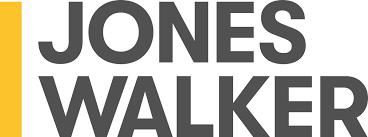


Education: Juris Doctor, Florida International University College of Law; BA, marketing cum laude, Loyola University New Orleans
Company Name: Jones Walker LLP
Industry: Law & legal services
Company CEO: Bill Hines, Managing Partner
Company Headquarters Location: New Orleans, Louisiana
Number of Employees: 500+
Your Location (if different from above): Miami, Florida
Words you live by: Keep it simple.
Who is your personal hero? Winston Churchill
What book are you reading? Principles by Ray Dalio
What was your first job? Intern for Flagler Development Group
Favorite charity: Shriners Hospitals for Children
Interests: Fishing
Family: Married, with 2-year-old twins
In my law career, I have worked hard and been committed to my legal practice. I was promoted to partnership in 2017, and I was chosen to be the head of Jones Walker’s Miami office in 2019. I attribute my successes to not only my passion for law but also to my upbringing—the unique experience of being raised in Miami as a first-generation American and son of Cuban exiles. Because my parents fled a communist dictatorship, I was always keenly aware of how lucky I was to live in this country and thankful for all of the opportunities it gave my family. I also believe my Jesuit education played a significant role in shaping my outlook on the world and the responsibility we have as “men for others” to better our community.
Latino business leaders must mentor and support the next generation. I think it is important to instill confidence in the next generation and teach them that their Hispanic background is an asset in the business world, since we are the fastest growing minority group in the United States. Accordingly, both leaders
in corporate America and in politics are always looking for ways to connect with the Hispanic community, which presents young Hispanics with a monumental opportunity to share their backgrounds.
As Latino business leaders, we have to encourage the next generation to embrace their heritage, master their mother language of Spanish, and expose them to businesses that value input from bicultural employees. I have been lucky enough to have mentors in my professional life like George Fowler, who made the most of his Cuban background to establish himself as one of the leading international lawyers in the United States. Similarly, in my personal life, my brother Tom has used his Hispanic background to achieve success in his career in broadcast journalism. Because of his Hispanic background, he has been able to conduct interviews with foreign leaders in Spanish, as well as deliver stories regarding immigration with a personal touch. Both of these mentors are very proud to be Latino and have leveraged their heritage to achieve

great professional success.
Personally, without my bicultural background, I do not think I would be adequately equipped to handle and efficiently respond to my various international cases. I am proud of my Cuban heritage, and I always want to make sure that Latino students, young professionals, and lawyers receive equal opportunities for education and employment. Within the firm, I am a part of the Jones Walker Women’s Initiative and co-lead its Latin American group. In my community, I was elected and serve as a board member of the Hispanic National Bar Foundation, an organization with a mission to help Hispanics achieve their potential through access to higher education and to increase diversity in the legal profession. I believe that it is important to recognize the opportunities granted to me by my professional and personal mentors, and that it is our responsibility as Latino leaders to pay it forward and continue providing these same experiences for younger community members.
Michelle Martinez Reyes Chief Relations Officer

Education: Executive Education, leadership essentials, Columbia Business School; MBA, global management, Nova Southeastern University; BA, political science and criminal justice, Honors College, Florida International University; AA, political science and government, Honors College, Miami Dade College
Company Name: Kelley Kronenberg
Industry: Law
Company CEO: Michael Fichtel
Company Headquarters Location: Fort Lauderdale, Florida
Number of Employees: 380
Words you live by: Listen to your instincts, they are usually correct.
Who is your personal hero? My mother
What book are you reading? The Nest by Cynthia D’Aprix Sweeney
What was your first job? I was a telemarketer.
Favorite charity: All things benefiting children and women
Interests: I love the beach and the ocean. I can swim all day and bake in the sun.
Family: My family is my son, Madden, and my fiancé, Art, and his two kids, Chris and Carlos.

I live by my mother’s wise saying that you are only as good as your last Atta girl! “ ”
I live by my mother’s wise saying that you are only as good as your last Atta girl! The oldest of four sisters, born and raised in the United States by Cuban immigrant parents, my educational and career path has brought me kudos and impressive stepping stones. However, I came from humble beginnings and worked my way up the corporate ladder, tackling challenges, as well as embracing rewards and accolades.
In 2020, I joined Kelley Kronenberg, one of largest and fastest growing multi-practice business law firms in the United States, as the firm’s chief relations officer. I previously served as the Chief Marketing Officer for Green-
spoon Marder, working as a member of the marketing and business development team for some of the largest law firms in the United States. I was not yet 40 years old, a solo parent, and full-time professional when I ascended to the C-Level among the AmLaw 200 and NLJ 300 ranks.
As a Latina woman, success is all the more meaningful to me. I was most recently named Corporate Latina Executive of the Year by Latina Style; one of the People of the Year and Top Women in PR by PR News; one of the Top Women in Communications as a Game-Changer by Ragan Communications and PR Daily; named among the Women of
Influence by Lifestyle, Top Women in Business by Boca and Delray magazine, Most Prestigious Women by South Florida Business & Wealth; a National Latino Leader by the National Diversity Council; and now a Latino Leader Worth Watching by Profiles in Diversity Journal
I’m thrilled to be able to work with some of the top businesses and clients in the United States. Every day, I have the opportunity to contribute and often bring something new and exciting to the table. It’s a time of growth and development now, more than ever. I love to be challenged and I am definitely a builder.



Andres J. Munar Co-Founder/Owner

Education: Associate degree, hotel restaurant management, Pennsylvania Culinary Institute
Company Name: Keystone Alliance Mortgage
Industry: Finance
Company CEO: Megan Marsh & Andres Munar
Company Headquarters Location: State College, Pennsylvania
Number of Employees: 24
Your Location (if different from above): Puerto Rico
Words you live by: Treat others as you wish to be treated.
Who is your personal hero? My mom and dad for being willing to give up their entire life in Colombia to give their sons a chance at a better opportunity in the States
What book are you reading? Flipping the switch…: Unleash the Power of Personal Accountability Using the QBQ by John G. Miller
What was your first job? Busboy
Favorite charity: The Sato Project
Interests: Travel, volleyball, road trips, beach, paddle boarding, and working out
Family: Mom, dad, brother, and dog named Bogota
Almost a year ago today, I had to choose respect, loyalty, and belief in my team when COVID-19 became a crisis and began shutting down business across the country. This is something I think many can relate to. When small businesses began letting people go, we refused to allow such a scenario to happen to any of our team. Just two weeks before the COVID-19 shutdown, Keystone Alliance Mortgage hired six new team members. For most small business owners this would have meant disaster.
My business partner and I could not fathom the thought of laying off people we just hired. Real estate was shut down throughout Pennsylvania, which meant new home purchases were at a standstill. New
purchases are a large part of our business. For new loan officers, getting new purchase business is literally all of their business.
Megan and I stepped up to the plate and put our team first. I stopped “running” the business and got back to selling. We opened our personal database of past clients to the loan-officer team. Together, we called as many past clients as possible and started filling up our pipeline with refinances. In doing so, our team-first approach to business literally allowed each and every one of us to keep our jobs.
Keystone Alliance Mortgage has an exceedingly rare and unique culture you won’t find at any other business. We believe that providing unmatched customer service and a
low-stress experience to our clients, referral partners, team, and community is the secret to their fast growth.
For our team, Megan and I have created a safe, inclusive, and diverse atmosphere that promotes personal and professional growth, along with a commitment to excellence. In my mind, success in business means putting the client’s needs first, while ensuring that our team succeeds in business, life, and the community.
Megan and I have led Keystone Alliance Mortgage during this pandemic to its best year ever. In the last year, the company has seen exponential growth. Keystone has expanded into helping homebuyers not only in Pennsylvania but also in Illinois, Ohio, Puerto Rico, and Florida. And we will soon enter several other states.


Education: Bachelor of Science, nursing, Master of Science, nursing, Master of Nursing Systems Management, University of Texas at El Paso
Company Name: Kindred Healthcare
Industry: Health care services
Company CEO: Benjamin A. Breier
Company Headquarters Location: Louisville, Kentucky
Number of Employees: Approximately 23,900
Your Location (if different from above): El Paso, Texas
Words you live by: Believe in yourself and never give up! Stay positive and keep people around you that have the same outlook in life. Lastly, stay humble and be kind to everyone.
Who is your personal hero? My grandmother, Antonia Salas Rodriguez
What book are you reading? Where the Crawdads Sing by Delia Owens
What was your first job? Fast food restaurant
Favorite charity: Center Against Sexual & Family Violence in El Paso
Interests: Triathlons (bike, swim, run), karaoke, fishing, and spending time with my family at the lake
Family: I have been married to my husband, Wayne Jones, for 25 years; we have two sons, Kody and Dylan
I am a Mexican-American Latina, raised by my grandmother from the age of five. I was able to overcome poverty and a family tragedy that left my siblings and me almost orphans. Our mother was shot and killed and our father taken to prison. Overnight, we went from having a loving family and home to having no parents and an uncertain future. After this horrific tragedy, our grandmother left her home and moved to El Paso to raise her five grandchildren. I was the youngest and felt the loss immediately.
Growing up on the south side of El Paso, Texas, in housing projects with gangs and drugs all around us was another challenge we had to overcome. Our grandmother set a strong foundation based on respect and hard work. Failure was not an
option and getting an education was an expectation. My strengths in school were in math and science, and I dreamed of becoming an electrical engineer. After one year at UT Austin, I was notified that my grandmother had been diagnosed with stage IV ovarian cancer. I came back home to help care for her through her cancer diagnosis, chemotherapy, and ultimately, her last days.
During her illness, I was exposed to the medical and nursing professions. The holistic and compassionate care provided by the hospice nurse during that time inspired me to change my major from electrical engineering to nursing. I found my calling in the most unexpected of circumstances. Becoming a nurse was
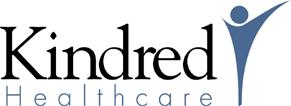



one of the most rewarding career decisions I have made. It has been an honor and a privilege to be able to touch the lives of patients and their family members throughout my nursing career.
As the CEO of Kindred Hospital El Paso, I have developed a strong culture of staff engagement and diversity based on respect, honor, and dignity. We are proud to have the lowest staff turnover rate in the hospital division and have been awarded the People Award for two years in a row for having the best culture. I am blessed and honored to work with one of the best leadership teams. Providing support to our health care team, and providing the best quality care to our patients, makes everything I’ve overcome well worth the journey.
Partner & Global Chair, Latin America Practice

Education: JD, New York University School of Law; BA cum laude in cursu honorum, Fordham University
Company Name: Latham & Watkins LLP
Industry: Law
Company CEO: N/A
Company Headquarters Location: N/A
Number of Employees: Approximately 4,500
Your Location (if different from above): New York, New York
Words you live by: We often can’t control outcomes in life, but we can control what we put into it—our effort, our preparation, how we care for and treat others, and our generosity as we pursue outcomes. I believe in staying positive even in the face of adversity and making the most of the time we are given.
Who is your personal hero? My mother, who came to the United States from Cuba, with my three older brothers and without anything to start a new life; and my father, who was not permitted to come with the family, but joined us later; my dad, a doctor, supported our family with odd jobs while he retrained to practice medicine in the United States.
What book are you reading? My favorite recent read was Legacy by James Kerr
What was your first job? While in high school, I did clerical jobs in my dad’s office and worked at a fruit market.
Favorite charity: ACCION (ww.accion.org), a microfinance organization whose mission is “to empower people who are underserved, revolutionizing financial services for people who are left out.”
Interests: Coaching youth sports (basketball, baseball, and soccer) and the theater Family: I am married to Alejandra; we have 3 children: Maximo (15), Joaquin (13), and Mateo (9). I also have four brothers.
As the son of Cuban refugees in the United States, and a witness to the socioeconomic obstacles they overcame, I recognized early on that the law affects nearly every aspect of society. I became the first in my family to attend law school, determined to build a career that allowed me to have a positive impact on, and support economic development in, the Hispanic community, not only in the United States but also in Latin America.
Early in my career, one of my mentors, Jose Fernandez, included me on matters related to the privatization of state-run enterprises in various Latin American countries. That experience—
working with government, multilateral organizations, and industry leaders—informs both my practice and my commitment to increasing access to economic opportunity.
As the head of Latham’s market-leading Latin America practice, I lead a diverse group of more than 50 professionals who are bicultural and bilingual and have lived in or come from the region. Our team includes professionals with ties to Argentina, Brazil, Chile, Colombia, Cuba, Dominican Republic, Mexico, Peru, Puerto Rico, and other areas.
I currently serve on the Board of the Council of the Americas (www. as-coa.org), a not-for-profit organization whose members share a commitment to economic and social
development, open markets, rule of law, and democracy throughout the Western Hemisphere. I also served on the U.S. State Department’s Advisory Committee on International Economic Policy from 2010 to 2015.
I know firsthand that mentorship and representation matter. Two decades ago, when I began to practice, there were relatively few Latino partners at elite law firms conducting the kind of cross-border transactions in which I was interested. Now, I chair a flourishing Latin American practice at one of the world’s leading law firms. I also serve as the partner advisor to the Hispanic and Latin American Lawyers Group at my firm.


Worth WatchingTM

Matthew H. Marmolejo Partner
Education: JD, Stanford Law School; Editing Chair, Stanford Journal of International Law; BA summa cum laude, University of California, Irvine; Phi Beta Kappa
Company Name: Mayer Brown LLP
Industry: Law
Company CEO: Paul Theiss
Company Headquarters Location: N/A
Number of Employees: More than 3,600
Your Location (if different from above): Los Angeles, California
Words you live by: “Nothing in the world can take the place of persistence.”
– Calvin Coolidge
Who is your personal hero? Abraham Lincoln
What book are you reading? Comrades by Stephen Ambrose
What was your first job? I had a summer job in high school bagging groceries at the local supermarket.
Favorite charity: The Orange County Human Relations Council. They do excellent work.
Interests: I’m an avid reader of military history, particularly WWII and the American Civil War.
Family: My six-year-old daughter is the light of my life. And my boss.
Reflecting on the trajectory of my career path, I attribute my development to three salient qualities that I hope will continue to guide me: (1) intellectual curiosity; (2) empathy; and (3) a deep appreciation of my roots. These are the three qualities that I most admire in other lawyers, and that have the most impact on how I approach my role as an advocate for, and an advisor to, my clients.
I credit much of my professional success to an innate sense of intellectual curiosity driven by the fascinating issues for which my clients seek my counsel. The focus of my practice is motor vehicle safety and, in particular, the interesting and complex regulatory scheme that underlies our country’s motor vehicle safety laws. I
am constantly confronted with new problems requiring solutions that integrate legal, business, and engineering perspectives. But on a more basic level, I just love cars, and I’ve been that way all my life. Now I get to work with some of the same vehicles that were on posters hanging on my bedroom wall when I was a kid. It does not get any better than that!
Empathy is a basic value that I try to practice in all aspects of my life, and my profession is no exception. I understand that my clients face many of the same stresses we all do. So I view my role not only as a means to provide creative and impactful legal solutions, but more fundamentally, as a way to solve my clients’ problems


and hopefully make them look good in the process. Being the “wind beneath the wings” of our important clients is a great way to build meaningful, successful relationships.
Finally, I don’t think anyone should ever forget his or her roots. Being a lawyer requires hard work and dedication—and lots of both. My grandparents came to the United States from Mexico with nothing. It was only through their hard work and dedication that many of the opportunities I have enjoyed were possible. The struggles they faced and overcame—coming to a foreign country with no family or friends, no network, and no money to speak of—serve as a constant reminder of what the human spirit is capable of accomplishing.
Risk Advisory & Compliance Manager


Education: BS, business administration, accounting (minor, ethnic studies), California Polytechnic State University, San Luis Obispo
Company Name: Moss Adams LLP
Industry: Accounting, Consulting
Company CEO: Chris Schmidt
Company Headquarters Location: Seattle, Washington
Number of Employees: 3,400
Your Location (if different from above): Hayward, California
Words you live by: Keep moving, make mistakes, but don’t give up.
Who is your personal hero? My abuelita (grandmother)
What book are you reading? Women Who Run with the Wolves by Clarissa Pinkola Estés
What was your first job? Cleaning rental chairs, tables, and jumpers for my uncle’s business
Favorite charity: La Clínica, a California health center (serving the East Bay area)
Interests: Playing and watching soccer, home gardening, and playing Rummikub
“ ”
Surrounding myself with those who have the leadership traits I wish to develop, or those who are already advancing in a role I am aspiring to, has been crucial to my personal and career growth.
A Mentor
Mentors can carry the official title of mentor or simply be role models who influence you by their example. One of the earliest role models was my abuelita Socorro. My grandmother, living in a one-bedroom adobe farmhouse, raised and provided for her 10 kids as a single mother, while my grandfather was a bracero in the North. Despite living deserted in a machista society, my grandmother did not concede but rather stood up, worked, and asked for what she deserved. Through her life example of working late nights and early mornings, and
not giving up, to make ends meet, my grandmother taught me the value of self-worth, a strong work ethic, and fighting for a fair shot at life. Another instance where a role model influenced me by example was Ms. Belden, my high school English teacher. Growing up, I didn’t have immediate examples or images of how to dress for business or professional events. In high school, when it came to class project presentations, I chose my outfit keeping my English teacher in mind. I would ask myself, “Is this something Ms. Belden would wear to

school?” Without knowing, my English teacher’s style and school dress code set me up for success as I rolled into job interviews, summer program internships, and now the workplace.
Surrounding myself with those who have the leadership traits I wish to develop, or those who are already advancing in a role I am aspiring to, has been crucial to my personal and career growth. Their shared knowledge has not only helped build my character, work ethic, and presentation, it has also led me to opportunities and broadened my point of view.
Eduardo Arabu Executive Director


Education: Master of Science, public policy & management, Carnegie Mellon University; Bachelor of Science, business administration, Northeastern Illinois University
Company Name: The National Hispanic Corporate Council
Industry: Association
Company CEO: Eduardo Arabu
Company Headquarters Location: Washington DC
Number of Employees: 1
Your Location (if different from above): Chicago, Illinois
Words you live by: Be Bold. Determination + Preparation + Luck = Success
Who is your personal hero? My parents, Eduardo and Arelys Arabu
What was your first job? Taco Bell associate
Interests: Athletics, travel, reading, puzzles, politics, aerospace, and the Civil Air Patrol
Family: Eduardo Arabu (father), Arelys Arabu (mother), and Kimberly Arabu (sister)

Today’s leaders can support the next generation of Latino business leaders by facilitating opportunities to connect, learn, share, and network. The best advice I ever received was that preparation + luck = success. My preparation framework for success features four key components: academics, experiences, skills, and networks. This framework should be applied and adjusted as a continuous process.
Latino and non-Latino leaders should leverage opportunities to increase awareness and cultural competency around the diverse U.S. Latino market. While there is a common root language and other similar attributes, the Latino market is complex as it is made up of many characteristics, as well as historical and migration factors. You should identify methods to be inclusive of Latino thought
leadership and strategies in your business operations. You can identify Latino associates to mentor and sponsor. Sponsorship is critical for career progression.
The majority of senior-level executives are non-Latino, so today’s Latino executives and associates should leverage their cultural diversity to educate and advocate for Hispanic strategies. Business leaders can advance their companies by including diverse markets. Since the “Great Recession,” 100 percent of consumer growth has been driven by multicultural segments. Of that, 50 percent is attributed to U.S. Latinos. The Latino market is 60 million individuals strong (or 18 percent of the population) and in the next few decades, that number will almost double to 111 million (or 30 percent of the population). Their purchasing power is

$2 trillion and growing. So as business leaders, you should ask the following questions: What opportunities are there to grow our company by enhancing our Hispanic talent, consumers, supplier, and communityrelations strategies?
The nexus of business and community involvement goes hand in hand. Many leaders and companies tout their diversityand-inclusion objectives. Many are successful, others are not. Some companies want your community’s dollars, but do not invest in those communities. Companies should have a robust corporate social responsibility that includes talent, suppliers, and communities. Companies should hire from diverse communities, not only because it is the right thing to do, but because studies have shown that it makes business sense.


Patty Arvielo Co-Founder and President

Education: N/A
Company Name: New American Funding
Industry: Mortgage Lending
Company CEO: Rick Arvielo
Company Headquarters Location: Tustin, California
Number of Employees: 4,800+
Words you live by: If you see it, you can be it.
Who is your personal hero? My husband, Rick
What book are you reading? OMG WTF Does the Constitution Actually Say?: A Non-Boring Guide to How Our Democracy Is Supposed to Work by Ben Sheehan
What was your first job? Clerical Position at TransUnion Credit
Favorite charity: Big Brothers Big Sisters of Orange County
Interests: Traveling and spending time with my friends and family
Family: My husband, Rick; daughter, Tara; and my two sons, Trevor and Dominic
“ ”
I work directly with eager learners from both outside and inside New American Funding to provide them with the tools they need to find success in their career. It’s also why I established a new internal mentorship program that will see experienced, senior-level employees matched up with earlier career employees for extensive guidance and career training.
I’ve been very fortunate in my career, having built a successful company that is thriving and reaching new heights with each passing month. Our success is driven by our people—they’re our greatest resource. Now, more than anything, I want to do everything I can to support them, and help them grow and build their careers in the mortgage business. My chief goal now is to see our amazing team members flourish. Mentorship is a passion of mine. I have long sought to share
my experience and expertise with those who are at earlier stages in their career to help them pursue their dreams. That’s why I established the “Thrive and Lead” mentorship program three years ago. Through that program, I work directly with eager learners from both outside and inside New American Funding to provide them with the tools they need to find success in their career. It’s also why I established a new internal mentorship program that will see experienced, senior-level
employees matched up with earlier career employees for extensive guidance and career training. These programs all have the same purpose: to continue investing in our most valuable asset, our people. They are the greatest investment I can make, and I have no plans of slowing down or scaling back. It’s just the opposite, in fact. I plan to continue mentoring and driving others to do the same. When our team succeeds, we succeed. Their growth is our growth. Their future is our future.


Managing
Director,
New York Life
Investments; Head of Global Marketing Operations
Education: Bachelor of Science, accounting, University of Central Florida
Company Name: New York Life Insurance
Industry: Financial Services
Company CEO: Ted Mathas
Company Headquarters Location: New York, New York
Number of Employees: 14,615
Words you live by: There are blessings hidden in even the most challenging times, you just need to look for them.
Who is your personal hero? I would have to say my sons. My eldest has a passion and drive that I could only strive for and my youngest has an incredible heart and overcomes even the hardest of obstacles.
What book are you reading? Caste: The Origins of Our Discontents by Isabel Wilkerson and The Memo: What Women of Color Need to Know to Secure a Seat at the Table by Minda Harts
What was your first job? I babysat since the age of 9, but my first W-2 job was as a hostess at Red Lobster.
Favorite charity: I give to several charities related to education: a local school focused on special education, a school in an area impacted by the hurricanes in 2017, and a charity dedicated to supporting Latinx students.
Interests: I love to read when I have time, but my favorite pastime is watching my son play baseball. I don’t miss a game.
Family: My husband, Marcelino, and two boys, Johnathan (15) and Matthew (12).
We delight in the beauty of the butterfly but rarely admit the changes it has gone through to achieve that beauty. – Maya Angelou Change…it is an act I am intimately familiar with. The daughter of an Air Force father, and a child of divorce, I attended 12 schools by the time I graduated from high school—from San Juan, Puerto Rico, to Queens, New York, and from Okinawa, Japan, to the U.S. Virgin Islands. As a young adult, I was not aware of the gift I had been given. Developing the ability to adapt to change would have a tremendous impact on my life and career. It would work to help me see the opportunity in the change, rather than focusing on the challenge.
In my personal life, my ability to adapt helped me on the day I received the news that my younger son, Matthew, was diagnosed with Autism. While the doctor offered me a box of tissues, I was busy asking what I need-
ed to do and where I needed to go to get him the services he needed. I quickly pivoted to focusing on the solution rather than the challenge. That is not to say that this was not a difficult chapter in my life, but that it felt more empowering to focus on what I could control rather than on what I could not.
In my career, resilience has been instrumental to my success. From my years in public accounting to running financial operations at a startup hedge fund, to my roles at New York Life in financial planning & analysis and project management & communications, my career path has not been linear. Each new role I have taken has not looked like the last. And, while this has helped me grow exponentially, it has not always been easy.
In 2019, after years in finance and dipping my toe into a couple of operational roles, I was offered the

opportunity to run Global Marketing Operations for New York Life Investments. I remember thinking that the chief marketing officer must be out of his mind to offer me this role, since I had zero experience in marketing. But I had leapt into the unknown before and been successful, so why not?
Once again, that strong adaptation muscle built during my childhood came into play. How many times had I found myself at a new school, in a new town, needing to make new friends and show my teachers that I could keep up? I jumped into the role overseeing five areas I had virtually no experience in, and I focused on my strengths: people and process. Nearly three years later, I would consider this most recent leap a success. My advice? Embrace change, it leads to growth. And always focus on the three things that I now impress upon my son…patience, practice, and persistence.


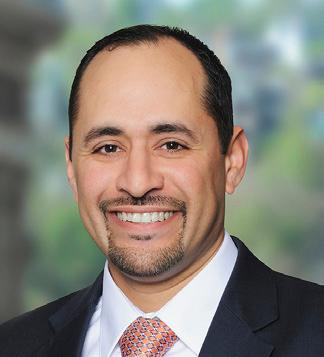

Pedro Viera, Jr. Vice President, Business Banking
Education: Bachelor of Science, business administration, finance management, Goldey Beacom College
Company Name: PNC Financial Services Group, Inc.
Industry: Financial
Company CEO: William Demchak
Company Headquarters Location: Pittsburgh, Pennsylvania
Number of Employees: 52,000
Your Location (if different from above): Wilmington, Delaware
Words you live by: “Great Leaders are always easy to follow, and you are a leader” – Pedro Viera, Jr.
Who is your personal hero? My parents and my family; I wouldn’t be able to name just one hero.
What book are you reading? The Bible
What was your first job? Cashier at a local supermarket
Favorite charity: Too many to name!
Interests: Spending time with my children, wife, family, friends, and the people in my community
Family: Thank you Christie, Christian, Sienna, and Nathan for your support.
Faith, a strong belief or trust, is the word I think about most when describing and demonstrating my definition of success to everyone I meet.
When I think about today’s leaders, I’m reminded of our ancestors who paved the way for us, and who have given us the opportunity to honor and respect their efforts. It is that awesome responsibility that motivates me every day to try to achieve success, while lifting the hearts and minds of the people around me.
My career has been built around enjoyment/felicidad and about helping others and finding ways to collaborate and focus on unselfishness. My joy comes from
the happiness of everyone around me. I take pride in building teams, ensuring the people around me recognize—and are recognized for—their contributions, advancing careers, and driving inclusive engagement.
A positive outlook that influences positive, forward-looking action is what motivates me most. Community development and volunteerism leads to so many great opportunities. My hope is that when we think about what we want for ourselves, we remember that we are successful because of the aid and support of wonderful mentors, allies, and sponsors—or as we say in Spanish, M.A.S.
I’m thankful for this honor and for being one of many people who could have received this award. I represent
every one of you. I think about the many wonderful friends, family, team members, mentors, mentees, and leaders who have helped shape my future, and who give me hope for a better one. You motivate, energize, and inspire me. You give me the passion and incentive to strive for more, learn more, and keep moving forward. Let’s continue to not only dream, but take action. Let’s make sure we remain proud of who we are, but also include others in our journey. Share your story with others, demonstrate what motivates you, and allow yourself to be inspired by those who are sharing your journey.
Always remember… Great leaders are always easy to follow, and you are a leader.

Michael Bonilla Senior Corporate Strategy Analyst


Education: Bachelor’s in Business Administration, marketing, from Saint Joseph’s University
Company Name: S&P Global Inc.
Industry: Financial Services
Company CEO: Douglas L. Peterson
Company Headquarters Location: New York, New York
Number of Employees: 22,500 globally
Your Location (if different from above): Stamford, Connecticut
Who is your personal hero? My parents
What book are you reading? Promised Land by Barack Obama
What was your first job? Retirement Services Representative at Merrill Lynch
Favorite charity: Alzheimer’s Association
Interests: Basketball, playing dominoes with the family, traveling, and movies

I would not characterize myself as an expert on how to achieve career success, but I can say there are a few fundamental traits to which I firmly attribute my success to date. The essay question says to name one essential trait, but from my perspective, it’s a collection of traits, constantly working like a heartbeat.
If I had to choose at least two traits essential to my success, they would be self-awareness and adaptability. As we all know, life tends to throw “curve balls,” and I’m a firm believer that the people who are most successful both know themselves and can adapt to any pitch thrown to them.
When I first started my career, I can attest that my self-awareness was not the greatest. My first job out of college was at a retirement call center for Merrill Lynch. As a newly graduated student, I was exuding confidence, and I was
convinced I was ready for this new challenge. As I went through the program, I quickly figured out that I was not interested in this career, but I did fall in love with the external factors (e.g., company name, benefits, potential career track after passing my certifications, etc.). I would work 10-hour days at the call center, study for another three to four hours, rinse and repeat. In short, I did not pass my certifications and was let go from the program. This was not a result of a lack of studying. It was more not being aware of my interests and the clear voice in my head saying, “This career-path is not for you.”
A year later, I found myself at S&P Global Market Intelligence, where I had interned throughout my four years in college. I could not help but think that I had made my way back to the company where I had previously found, and

where I truly felt, I could build a career. I vowed to myself to always be self-aware and to trust my initial feelings regarding any opportunity that might arise in the future.
While in this position, I figured out that the most successful leaders have well-rounded careers. So I decided that any new position I accepted would be in an area of the business in which I had no experience, and I told myself to be adaptable. Since then, I’ve held positions within the content, commercial, and product sides of the business, and I now work within a corporate function that serves all of the divisional companies.
In the end, I believe there are two factors to consider for career success: what we can control and what makes us happy. Selfawareness and adaptability are just two traits that have helped in my journey.

Marcela Mikkola
Senior Research Associate

Education: BA, Syracuse University; MA & PhD, University of Denver
Company Name: S&P Global Inc.
Industry: Financial Services
Company CEO: Douglas L. Peterson
Company Headquarters Location: New York, New York
Number of Employees: 22,500 globally
Your Location (if different from above): Denver, Colorado
Words you live by: “Árbol de la esperanza, mantente firme.” – Frida Kahlo
Who is your personal hero? Jane Goodall, my mother, and all the strong women who have supported me throughout my life
What book are you reading? Democracy in Black by Eddie S. Glaude; El Tiempo Entre Costuras by Maria Dueñas; and The Moor’s Account by Laila Lalami
What was your first job? Cafeteria ID checker at Syracuse University, freshman year
Favorite charity: The Humane Society, Friends of the Earth, and The MaxFund Inc.
Interests: Read, travel and view wildlife in their natural habitats, and volunteer at the Denver Zoo
Family: Mother, brother, cat (Mr. Pooh), and all my closest friends
I hope that we can implement sustainable solutions that protect and preserve natural habitats, while supporting economic development of vulnerable communities.
As an avid animal lover and conservationist, one of my biggest privileges has been to travel internationally to observe animals in their natural habitats. Although I enjoy seeing wildlife living freely in their natural ecosystems and appreciate the surrounding habitats, I have also seen firsthand the impact climate change has had on the environment and rural communities. Natural disasters, economic depression, poaching, and illegal wildlife trafficking are all consequences of climate change, which also disproportionally impact low-income communities and people of color. Developing regions in Africa, Asia, and Latin America often bear the brunt of climate and ecological catastrophes, despite having contributed the least to them. Additionally, economically stressed communities in wealthier countries face similar

struggles related to environmental injustice. This was evident during the COVID pandemic of 2020— globally, people of color have limited access to health care, don’t receive the same quality treatment, and experience the greatest economic challenge.
My hope is that we can come up with sustainable solutions that address racial injustice, reduce abject poverty, and move toward an approach that engages local communities. This shift will not only provide economic opportunities for vulnerable communities, but will also provide incentives and opportunities to protect wildlife and the environment. To protect wildlife in Africa, Latin America, and Asia, we must begin by engaging with the communities that are better positioned to help us, and we must address issues of climate change head on. We must meet their needs first; we must listen to them, and we must work with them, because in the end, fighting against poverty and fighting for the environment

are essentially the same fight.
I am fortunate to work for a company that is actively accelerating and investing in environmental, social and governance (ESG) practices that promote sustainability and understands that racial justice, global markets, and sustainability are all interrelated. S&P Global’s data and analytics help companies and investors assess ESG-related risk, uncover opportunities and inform long term sustainable growth.
Finally, by making environmentally conscious decisions in our daily lives and taking small steps in our own communities, we can have a far-reaching global impact. Support your national parks; do not buy plastic water bottles; buy recycled goods; eat locally; reduce your carbon footprint by driving less and walking, biking, or taking public transportation; do not buy ivory, coral, or other products from illegally trafficked wildlife. By becoming environmental advocates, we become humanitarian champions.
Nicole Rodriguez
Senior Director, People Strategy Lead
Education: BA, communication, Villanova University
Company Name: S&P Global Inc.
Industry: Financial Services
Company CEO: Douglas L. Peterson
Company Headquarters Location: New York, New York
Number of Employees: 22,500 globally
Your Location (if different from above): Jacksonville Beach, Florida
Words you live by: “Fight for the things that you care about, but do it in a way that will lead others to join you.” – Ruth Bader Ginsburg
Who is your personal hero? My parents, Juana & Horacio, who inspired me to stay motivated against all odds
What book are you reading? White Fragility: Why it’s so Hard for White People to Talk about Racism by Robin DiAngelo
What was your first job? Publicity Assistant, DKC PR & Communications
Favorite charity: God’s Love We Deliver
Interests: Learning how to play tennis, gardening, and running on the beach
Family: Looking forward to marrying my partner, Andrew, in December; loved growing up with 3 sisters


Early in my Public Relations career, I struggled to understand how my work was making a real impact on my organization. I began to research different career paths and became curious about human resources and the role this function plays in shaping career experiences. I decided to pursue an HR role and was hired into a talent acquisition position, where I started to learn about how a strategic HR team functions.
I saw recruiters play a role beyond the interview process and effectively work with business leaders to place candidates in the right roles, while maintaining touchpoints past hire start date to ensure new hires were successfully adjusting to company culture. In addition to learning about talent strategy, change management, organizational development, and workforce analytics, I learned how
effective HR leaders can influence business strategy to leverage a company’s most important asset— its people. It was then that I knew I wanted to continue developing my HR capabilities and help others thrive in their career journeys.
I am inspired by my ability to make an impact in my organization.
In my role, I work with our People Team to solve problems that our people face every day, as well as implement proactive strategies to enhance career engagement and professional development. When COVID-19 hit, I had the opportunity to work with team members and colleagues across the organization to ensure that our people were feeling safe and had the right working environment to succeed at home.
I saw our S&P Global leadership team work at an accelerated pace
to make critical decisions regarding COVID-19’s impact on our people. It was inspiring to see my colleagues work together in a fast and effective way to reach a common goal. The countless stories and outpourings of gratitude I heard from team members regarding how supported they felt during this pandemic made me proud to work for an organization that puts people first.
I also spearheaded an effort to bring wellness tools and guidance to our people to help build healthy habits and develop mental resilience. It is rewarding to know my role helps create initiatives that positively impact our people. I feel very connected to my work and grateful to have the opportunity to work on a team that shapes our People Strategy in a meaningful way.



Senior Director, Operations; Site Lead, Buenos Aires Office

Education: Bachelor´s degree, economics, Universidad de San Andrés
Company Name: S&P Global Inc.
Industry: Financial Services
Company CEO: Douglas L. Peterson
Company Headquarters Location: New York, New York
Number of Employees: 22,500 globally
Your Location (if different from above): Buenos Aires, Argentina
Words you live by: Freedom, responsibility, respect.
Who is your personal hero? I don´t have personal heroes, but there are people who I admire for particular reasons. Nelson Mandela is one of them. What book are you reading? The Burnout Society by Byung-Chul Han
What was your first job? Summer Job in the finance department of a food products company
Favorite charity: Medecins Sans Frontieres (MSF) and the OGA, my school’s Graduates Association, focused on educational programs in the community.
Interests: Playing the piano, classical music, reading, and cooking
Family: My two daughters
During the last 12 years, I’ve been working in management positions and as site leader in Buenos Aires, where I live. I’ve had the opportunity to see our local office develop into a workplace with amazing characteristics and a predominance of multicultural and multi-academic profiles. This was the result of hiring, with a focus on the linguistic skills required for the core of our work and the availability of this type of talent in our city.
As people left and new colleagues joined, this diversity remained and became a distinctive aspect of this office. It delighted many of us working there; we celebrate these different cultures and typically slide in a comment related to this fact when answering the usual “Where do you work?” question. It was something visitors from other offices always highlighted, and our internal employee surveys nearly always mentioned our diversity when asked to describe the workplace.
For one of our Employee Resource Group conferences, we invited a
professor of constitutional law and human rights who specialized in gender identity legislation. She had visited and learned about our office prior to this event and was aware of the audience to whom she was speaking. She ended her remarks praising the diversity she could see in our office, noted that consistently over the years we had a high percentage of women in leadership positions, and then paused for a final comment—she said that it was not enough. She prompted us to think about which other groups of underrepresented minorities were not part of our office population, and to realize that if we did not make a conscious effort to understand why, we would just be settling. At that point, I felt that this could have been the result of unconscious bias.
This conference was a trigger to think about what else we could do— about our possibilities, given the types of roles we needed to fill. As we sought to further diversify our office, we encountered hurdles related to deeper
structural problems in our community, such as access to education and transportation, among others.
When thinking about the problem of unconscious bias and how to combat it, there are two tools I feel are within reach. First, structural problems will require the coordinated work of different social actors and the development of practices that give each of us the opportunity to contribute in impactful ways. We can choose to participate in, and even, drive this. And second, was settling for a relatively good hiring result a form of bias, a blind spot? Most probably. Neuroscientists have been publishing new information about the functioning of our brain, our perception of reality, and the role of implicit biases in our day-today decisions. How could these tools and this knowledge help overcome unconscious biases and help create more diverse and fair workspaces?
There is still a lot of work ahead, but I like to think that these options are possibilities available to all of us.


A. Elizabeth Korchin Senior Investment Officer

Education: JD, Harvard Law School; AB, Duke University
Company Name: Therium Capital Management
Industry: Legal Finance
Company CEO: John Byrne (Global), Eric Blinderman (U.S.)
Company Headquarters Location: London, United Kingdom
Number of Employees: 40+
Your Location (if different from above): New York, New York
Words you live by: “Above all, watch with glittering eyes the whole world around you, because the greatest secrets are always hidden in the most unlikely places. Those who don’t believe in magic will never find it.” – Roald Dahl
Who is your personal hero? My parents and grandparents
What book are you reading? The Peace of Wild Things by
What was your first job? Barnie’s Coffee & Tea at my local mall when I was in high school
Favorite charity: Children’s Rights (www.childrensrights.org)
Interests: Hiking, Duke basketball, and environmental sustainability

Something that really has helped me throughout my career is that my parents and grandparents demonstrated (and therefore instilled in me) a love for tackling the unknown, as well as a confident and fearless mentality when doing it. When I was a child, my mother wanted a red convertible, and we couldn’t afford to just go out and buy one, so my father spent years learning to build one for her in our garage (and the car actually drove when he was done!). Also, my mother went to school at night while working full time, completing her bachelor’s, master’s, and doctoral degrees, all while I was growing up. They, like their parents, took on many endeavors that conventional wis-
dom would have said they had no business taking on, and what was most influential for me was that they accomplished what they did by figuring out what worked for them.
Because of their influence, my natural problem-solving style always has been to ask, “What can I do?” rather than, “What am I supposed to do?” While this can be a double-edged sword at times (no doubt people sometimes have been frustrated by my unconventional tactics), it has helped me stand out in my career as someone willing to take a fresh, creative approach. And, on a personal level, it has made my career that much more fulfilling because, at every step, I have
taken the path that felt right for me, rather than doing what others might expect.
For example, I left my former law firm in 2018—just six months after making partner—when I was recruited into an uncharted career in what was then the very young industry (in the United States) of legal finance. While many did not understand my actions at the time, it is now clear that it was absolutely the right move for me.
I’m grateful to my family for giving me the confidence to trust my instincts and to forge my own paths—both because it has enabled me to be successful in my career and because it has enabled me to define for myself what success truly looks like.

Page removed per award winners request
Vice President, Enterprise Business Intelligence
Education: Execution Engineering in Information Processing, Universidad de Chile
Company Name: UnitedHealthcare Global
Industry: Health care
Company CEO: Amy Shaw
Company Headquarters Location: Minnetonka, Minnesota
Number of Employees: 325,000
Your Location (if different from above): Santiago, Chile
Words you live by: Always look forward with confidence.
Who is your personal hero? My daughter, who is always positive
What book are you reading? Shoot, I’m Already Dead by Julia Navarro
What was your first job? IT project analyst, Lan Chile
Favorite charity: Fire Department (In Chile they are pro bono)
Interests: Gardening, cooking, trekking, and traveling with my family
Family: 3 children (2 men and 1 woman); I like my extended family also: grandparents, uncles, and nephews


I believe that life presents us all with situations we must face, and as a work team, we must have understanding and support in those circumstances, since we are all human beings and we need to live in community. “ ”
When I came to Banmédica (now part of UnitedHealth Group) more than 30 years ago, I worked for the operations manager. She had a very good “firm and close” leadership style, and I learned many things from her. At that time, there were very few women in high places. However, due to a health problem, I left the computer science department and switched to a business area, which allowed me to create a different professional career.
I met another female leader, with whom I started a friendship that I still have to this day. She had a different style of leadership—one that gave great importance to people and human relationships. This new
professional route involved a lot of teamwork, training people, thinking about their careers, deciding how to move forward, pushing the organization, and moving with teams of men and women. It also allowed me to work very closely with male leaders who had different, but complementary, work styles, and with leaders from other countries, including some like Colombia, where women have been in the workforce for many years.
For me to lead is to motivate, support, train, and share—it is to be a working family. Work has always been an important part of my life, due to the time and energy that one must allocate to it, but I con-
sider that I have achieved a balance with my personal life and am very happy in both areas.
Although there are some who are born with more privileges, within a team of people, it is necessary to have diversity to achieve respect, balance, and better results. I believe that life presents us all with situations we must face, and as a work team, we must have understanding and support in those circumstances, since we are all human beings and we need to live in community.
I believe that by having greater diversity, the organization and the clients win, since more complete leadership is generated.



Nora E. Garrote
Partner; Co-Lead, Intellectual Property Transactions Practice Group; Partner in Charge, Diversity & Inclusion

Education: JD, Columbia University School of Law; BA, Bryn Mawr College
Company Name: Venable LLP
Industry: Law
Company CEO: Stuart Ingis, Chairman
Company Headquarters Location: Washington, DC
Number of Employees: 1,400
Words you live by: Treat others the way you want to be treated.
Who is your personal hero? My father is my hero, for his optimism, hard work, compassion, and kindness to all
What book are you reading? 400 Hundred Souls: A Community History of African America, 1619-2019 edited by Ibram Kendi and Keisha Blain
What was your first job? Department store salesperson (during college summer break)
Favorite charity: Legal Aid Society of the District of Columbia
Interests: I love to travel with my family and discover new destinations. I also enjoy musical theater and lake kayaking.
Family: My husband and I have two wonderful adult sons.
Having practiced technology and intellectual property law for many years, I have been privileged to work with clients and colleagues who have allowed me to learn, placed their trust in my abilities, and provided me opportunities to grow professionally. I have had a front row seat from which I have been able to view the evolution of technology, and its role in creating unparalleled access to information and solutions for everyday and complex problems. I truly love what I do, the clients, the projects, and the satisfaction of a job well done.
Through the years, my definition of success has evolved. At different times, simply finding and keeping my job, making it through the day, barely managing work-life balance, and developing client relationships have all been markers of success. While I don’t recall having clearly identified mentors, I landed on my feet most of the time, through both good and challenging situations. This suggests
to me that I was, in fact, mentored during my earlier years in the practice. It was organic and subtle, and it has prompted me recently to reflect on the nature of mentorship today, especially for lawyers of color, and on the duty we have to consciously mentor others and pay it forward.
Measuring success by external accomplishments may be (as it was for me) an objective metric, based in large part on what is traditionally “expected” of women. Thus, we may fail to take advantage of the growth and learning that comes from the professional journey itself and the relationships available to us. Success, instead, may be better regarded as a corollary to mentoring and being mentored, and the rich experience that hopefully derives from that.
Whether one is a mentor or a mentee, mentoring must be intentional, visible, acknowledged, and mutually committed. It must go well beyond checking the box by merely assigning
someone a mentor. It requires defining roles and responsibilities for mentors and mentees, and insisting on accountability for the results. Both mentor and mentee should learn and grow. In some settings, mentoring relationships may be organic because of backgrounds and interests shared by colleagues, yet that is often not the case for people color. Partners, business professionals, and other workplace leaders must ensure that mentoring programs are robust, and the act of mentoring is an express job requirement.
I have recently been given the opportunity to lead Venable’s diversity and inclusion efforts. I am so thankful to my firm and humbled by the gravity and significance of my new responsibilities. Promoting and strengthening mentoring of that visible and empowered variety will be a priority. Along with my partners, I am hoping we help redefine success for a new generation of attorneys.


Daniel Trujillo
Executive Vice President, Global Chief Ethics & Compliance Officer

Education: LLM, international commercial law, UC Davis School of Law, Davis, California; MBA, University of Deusto, Spain & University of Salvador, Argentina; Juris Doctor, University of Buenos Aires, Argentina
Company Name: Walmart Inc.
Industry: Retail
Company CEO: Doug McMillon
Company Headquarters Location: Bentonville, Arkansas
Number of Employees: 2.2 million
Your Location (if different from above): North West Arkansas, Bentonville
Words you live by: Be yourself. Don’t try to be anyone else. Honor your values and never forget where you started. The real value is not in what you accomplish but in who you are as a person and how you help others with their accomplishments. Who is your personal hero? My father. He was the most loving person I ever met— strongest integrity, hard working, and dedicated to doing what was right for his family and everyone else. He was always helping others. He always told me that he did not care where I was going to study or what I was going to do, provided that I was a good person. What book are you reading? Unleashed: The Unapologetic Leader’s Guide to Empowering Everyone Around You by Anne Morriss and Frances Frei
What was your first job: My first job was in a civil court in Argentina where I am from. At that time, I was working from 6am to 2pm, so I could go to the University during the afternoon and at night. I learned a lot and it helped test my integrity, which was great as my values are my biggest asset.
Favorite charity: So many great ones, not only in the United States, but also in other countries. The ones focused on helping kids always get our attention.
Interests: Triathlon. I love testing my endurance limits as much as I can. I feel that endurance sports have an incredible similarity to life. You have to respect the process to progress. You have to believe in yourself. You need to keep focus on what you can control. You need to take risks, and consistency and resiliency are paramount for success.
Family: My lovable wife and two awesome kids (Tessa, 12 and Tobias, 10), who are everything to me.
I started my career with a lot of misconceptions. I thought that a career was like going up a ladder. My 32 years of work proved to me that a career is a lattice. While each new opportunity brought growth and unique challenges, my career movements were not always vertical.
From the beginning, I noticed colleagues paying too much attention to titles and positions. Thankfully, I followed my instincts and values, and focused on learning, experiencing, and helping others. I learned that it was, and it still is, a journey.
I grew up seeing my father working at different jobs and always giving his very best. I also saw him helping others, even if he probably needed more help than the ones he was helping. At the same time,
I saw my mother being incredibly resilient in the face of the many challenges life threw at her. It always felt right to incorporate the values my parents instilled in me into how I drove my career. I learned a sense of ownership.
I saw firsthand how entitlement and lack of values and purpose had a “killing effect” in people’s lives and careers. I was lucky to see my father taking the risk, but it was a risk with a purpose and was grounded in his values.
I took a lot of risks as well. It never felt easy, and the reward didn’t always arrive when I expected it, but I was also patient. I believed that consistent effort, following your purpose, being transformational, and creating value for others would provide something good in


the long run. I gained satisfaction knowing that I navigated many different environments, challenges, and situations, without betraying my values and who I am. That led me to understand how important it was to know who I am. I also learned how important it was to believe that everything would be okay if I was consistent, followed my values, and did not believe in magical outcomes.
I believe in the power of hard work, helping others, and being myself. My story fed my career and there were ups and downs as there are in everything in life. My best advice to anyone beginning their career is always to be yourself and keep in mind that what you give to others is more important than what you receive.


Education: JD, University of Colorado School of Law; BS, psychology, University of Iowa
Company Name: WilmerHale
Industry: Law
Company CEO: William F. Lee
Company Headquarters Location: Washington, DC
Number of Employees: 2,015 (number of attorneys: 1,055)
Your Location (if different from above): Denver, Colorado
Regina “Gina” Rodriguez is a leader in both the law and civic life, well known in the Denver area for her accomplishments as a trial lawyer with more than 30 years’ experience in both private practice and the federal government, and as a board member of numerous educational and charitable organizations. Her achievements as a trial lawyer were so highly regarded that President Obama nominated her to a federal judgeship. She has tried more than 30 cases as lead counsel. As an assistant U.S. attorney for Colorado, she was chief of the Civil Division.
Ms. Rodriguez is a Gunnison, Colorado, native. Her father’s
family emigrated from Mexico. Her mother’s Japanese-American mother was ordered to an internment camp in Wyoming during World War II. Ms. Rodriguez earned her undergraduate degree at the University of Iowa and her law degree at the University of Colorado School of Law, which is where she decided she would become a trial lawyer.
She is one of the Mountain West’s top litigators, known for skillfully handling particularly complex litigation across a range of industries. She is a fellow of the American College of Trial Lawyers, a coveted recognition among lawyers. During her public-service
years, besides holding a senior position in the U.S. Attorney’s office in Colorado, she worked in Washington, DC, at the U.S. Department of Justice as a deputy senior counsel.
Ms. Rodriguez has long served on the boards of numerous organizations focused on young people and economic development. She is on the boards of Metro Denver Chamber of Commerce and the Denver School of Science and Technology. She previously served on the board of Latinas First Foundation and as a commissioner on the Colorado Commission for Higher Education.


Education: JD, University of San Diego, School of Law; MSc, London School of Economics and Political Science; BA, Harvard University
Company Name: Wilson Turner Kosmo
Industry: Law
Company CEO: Claudette Wilson
Company Headquarters Location: San Diego, California
Number of Employees: 86
Words you live by: “Fight for the things that you care about, but do it in a way that will lead others to join you.” – Ruth Bader Ginsburg
Who is your personal hero? My mother and father (always); Amanda Gorman (currently)
What book are you reading? The Vanishing Half by Britt Bennett
What was your first job? Preschool teacher at an international school in Italy
Favorite charity: Partners in Algebra & The Turner Dream Foundation
Interests: Flamenco, traveling, and hosting dinner parties
Family: Husband (Andrea Petri), 11-year-old daughter (Ana Sofia), and 6-year-old son (Santiago)
I eagerly befriend, mentor, and sponsor young law students and attorneys of color. And all because these things make up who I am—they are me, unapologetically and authentically me. “ ”
“It takes courage to grow up and become who you really are.” – E.E. Cummings
The best advice I have ever received came at a moment when I needed it most.
“Be unapologetically yourself,” she told me, as I sat drinking un cafecito with four accomplished Latina attorneys (probably for the first time in my life), asking for advice on how to approach my firm about becoming partner. Thanks to that advice, I not only became a partner at the firm of my dreams, but I have become a more complete and more joyous version of myself.
Several years ago, five of us Latina attorneys in San Diego decided to

start meeting monthly to have a cafecito and talk about our experiences in the legal field. But these meetings quickly became about so much more. These women have since become dear friends, important confidantes, and immensely pivotal life coaches. Each in her own way has helped me embrace my authentic self, which in large part has been shaped by the intersectionality of my gender and my multicultural, multilingual upbringing (I am Chilean and Iranian). The reason I have so often felt different is because I am different, and that means my authentic self will be different. Watching these women, mis amigas, being unapologetically themselves made me truly believe
that it was okay.
Thanks to these friendships, and the lessons in authenticity I have learned over the years at our cafecitos, I am now simply more comfortable in my own skin. I own the fact that I have a conciliatory and nonaggressive litigation style. I proudly pronounce my name correctly. I point out the value of my multicultural upbringing and contribution to diversity of thought. I readily call out and interrupt biases and microaggressions. I eagerly befriend, mentor, and sponsor young law students and attorneys of color. And all because these things make up who I am—they are me, unapologetically and authentically me.








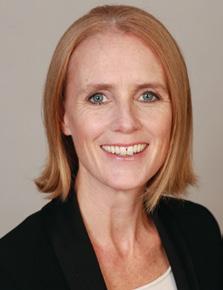

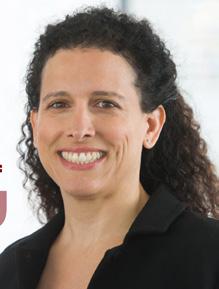






Over the years, PDJ has recognized more than 2,000 Women Worth Watching. In this issue, we catch up with a dozen more past Award recipients, who, since winning, have been promoted, started their own companies, taken on new roles, or moved into new fields of endeavor. They continue to be dynamic leaders, who welcome challenges, embrace change, and share their knowledge and experience with the next generation of women. Read on, and discover where their professional journeys have taken them.



Where are they now...
Susan Paternoster, recognized as a Woman Worth Watching in 2014, today is senior vice president and U.S. CIO for Wilton Re, a leading provider of in-force and reinsurance solutions in the North American life insurance industry.
Previously, Paternoster served in leadership positions at New York Life (where she worked when she was recognized as a Woman Worth Watching), Citi, and Deutsche Asset Management. Early in her career, she held management positions with Bankers Trust and KPMG.
Paternoster earned her BBA in MIS and marketing at Western Connecticut State University and her MBA in finance at University of Bridgeport. She also holds a 99 License issued by the Financial Industry Regulatory Authority.




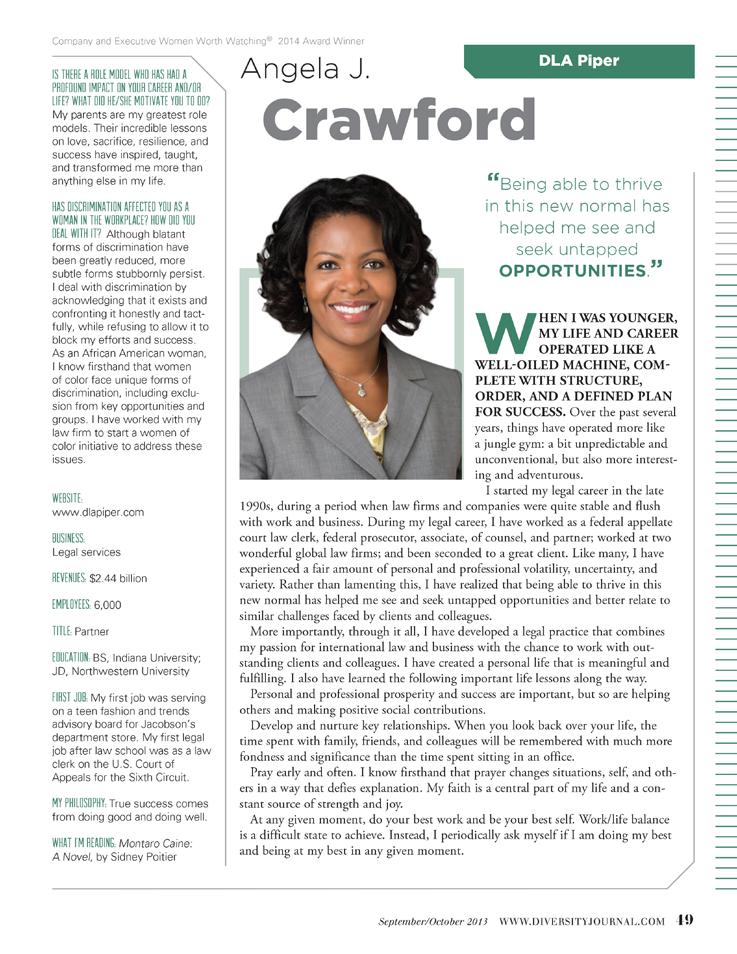
Angela Crawford Partner, Crawford & Acharya pllc
Where are they now...
A 2014 Woman Worth Watching, Angela Crawford now uses her experience in global compliance and investigations to help clients effectively and efficiently identify and remediate compliance and regulatory issues as a partner with Crawford & Acharya.
Prior to joining her current firm, Crawford was a partner with the firms of DLA Piper and Kirkland & Ellis. She also served as an assistant United States attorney. Early in her career, she was a judicial clerk to the Honorable Nathanial R. Jones.
Crawford holds a Juris Doctor from Northwestern University School of Law and a Bachelor of Science from Indiana University Bloomington.



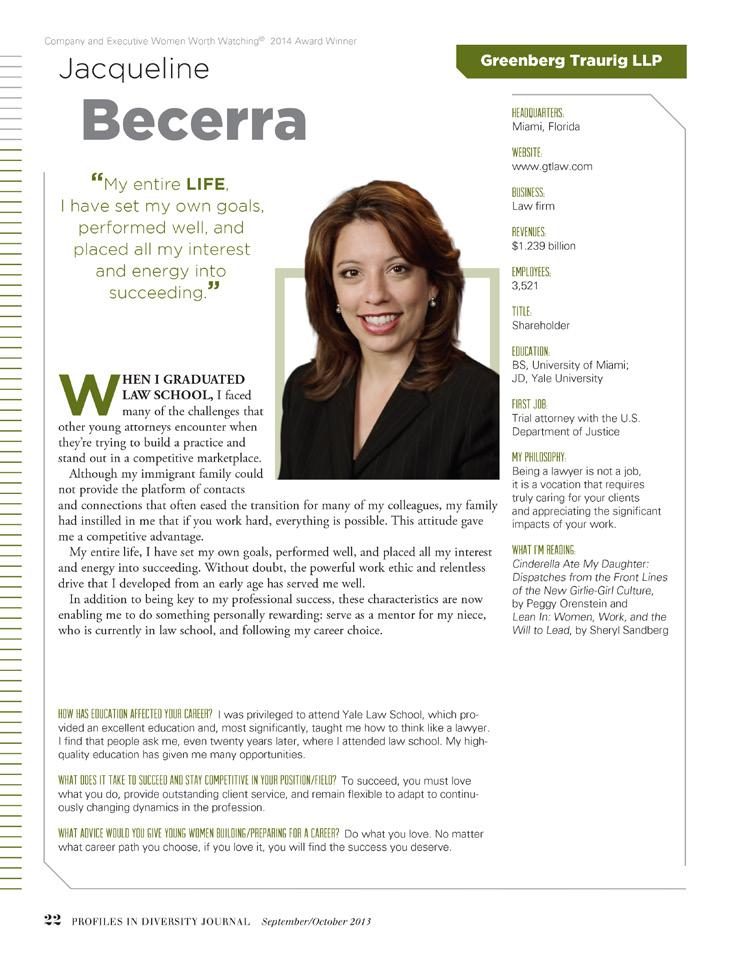
Judge, United States District Court for the Southern District of Florida
Jacqueline Becerra, a 2014 Woman Worth Watching Award recipient, recently became a judge in the United States District Court for the Southern District of Florida.
Prior to becoming a U.S. District Court judge, Becerra was a shareholder at Greenberg Traurig for 17 years. Earlier in her career, she served as a trial attorney with the United States Department of Justice.
Becerra holds a JD from Yale Law School and a bachelor’s degree from the University of Miami.



Where are they now...
Frances Allen, recognized as a Woman Worth Watching in 2014, now serves as chief executive officer for Checkers & Rally’s Drive-In Restaurants.
Before joining Checkers & Rally’s Drive-In Restaurants, Allen was the CEO for Boston Market, brand president for Jack in the Box, and executive vice president and chief brand officer for Dennys. She also served in leadership roles at Dunkin’ Donuts, Sony Ericsson, and PepsiCo earlier in her career.
Allen received her undergraduate degree in mathematics and actuarial studies from the University of Southampton and completed Harvard Business School’s Advanced Management Program.




& Region Bank President, San Francisco, California, Wells Fargo
A 2015 Woman Worth Watching Award recipient, Ina Stewart-Murray recently joined Wells Fargo as the company’s executive vice president and region bank president, San Francisco.
In addition to previously having served as executive vice president and market manager with PNC, the role she had when she was named a Woman Worth Watching, Stewart-Murray also held the position of region manager for Washington Mutual.
Stewart-Murray is a graduate of the Pacific Coast Banking School. She earned her bachelor’s degree summa cum laude from Arizona State University.




Where are they now...

Marisa Iasenza Chief Legal Officer & Corporate Secretary, Edgewell Personal Care
A 2015 Woman Worth Watching, Marisa Iasenza is now the chief legal officer and corporate secretary for Edgewell Personal Care.
Before joining Edgewell, Iasenza served as general counsel and corporate secretary at HARMAN, assistant general counsel at United Agri Products, and senior associate at the firm of Stradling, Yocca, Carlson & Rauth.
Iasenza received an LLM from the University of Miami School of Law, LLB/BCL from the University of Ottawa School of Law, and a BA in economics from McGill University. She also completed the Columbia Essentials of Management Program at Columbia University’s School of Business.




Where are they now...
Kathleen Elie, honored as a Woman Worth Watching in 2015, has since become the chief financial officer for Urban Arts Partnership.
Previously, Elie served as director for Charter School Business Management Inc., director of finance at Bronx Community Charter School, and assistant director of finance at Prep for Prep, a leadership development program that offers promising students of color access to a private school education.
Elie holds a master’s degree in public administration from Baruch College and a bachelor’s degree in sociology from the State University of New York at Stony Brook.



Where are they now...
Named a Woman Worth Watching in 2015, Alex Johnston recently became the chief executive officer for 360 Concussion Care.
Prior to joining her present company, Johnston served as vice president of strategy and public affairs at CBC/Radio–Canada and executive director, Canada for Catalyst, Inc. Earlier in her career, she held the position of policy director for the Government of Ontario, Office of the Premier.
Johnston earned her LLB/BCL degree (with Distinction) from McGill University–Faculty of Law and a BA in history (with Honours) from McGill University. She also studied Mandarin at the Beijing Language and Culture University.




Where are they now...
Catherine Powell, recognized as a Woman Worth Watching in 2016, recently made the move to Airbnb, where she currently serves at the company’s global head of hosting.
Powell comes to Airbnb from The Walt Disney Company, where she held leadership roles in France and the United States. Previously, she held marketing and management positions across the Middle East, Europe, and the UK for BBC Worldwide.
Powell earned a master’s degree from Oxford University, where her studies were concentrated in philosophy, politics, and economics.
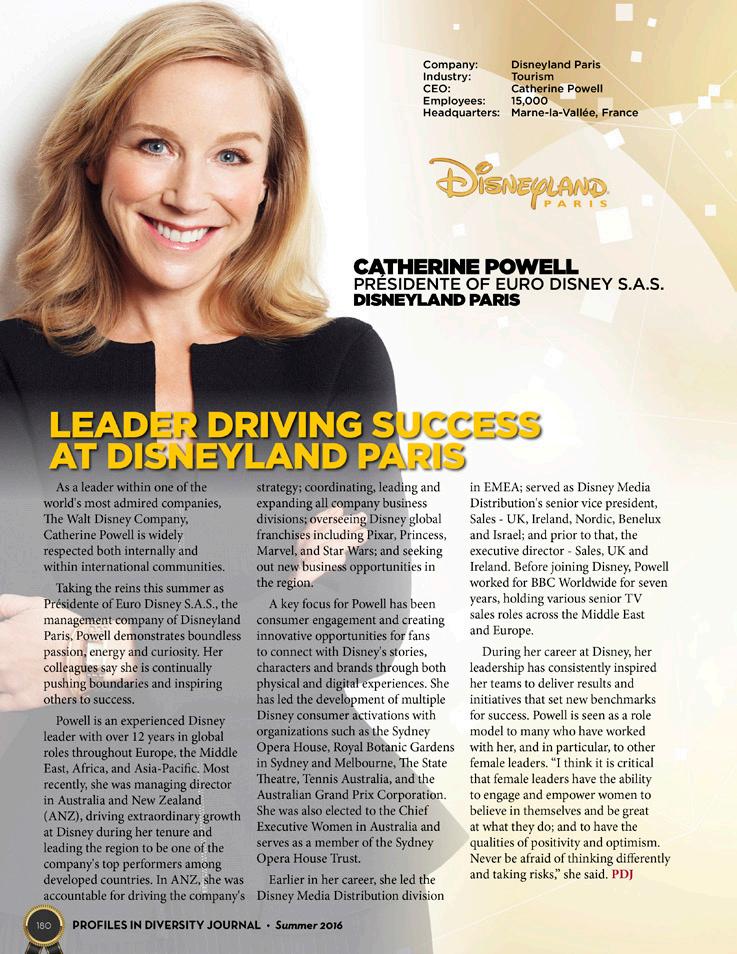




Global Head Partner Marketing and Programs, Procore Technologies
Named a Woman Worth Watching in 2016, Penelope Delgadillo Valencia recently joined Procore Technologies, where she serves as global head partner marketing and programs.
Previously, Valencia served as principal at Opel Group, global head of partnership marketing at PayPal, senior vice president of global audience & strategic partner ecosystem marketing at SAP, and director at Microsoft.
Valencia is a graduate of UCLA, where she earned a bachelor’s degree in political science. She also completed a Management Development Certification Program at the USC Marshall School of Business.



Where are they now...
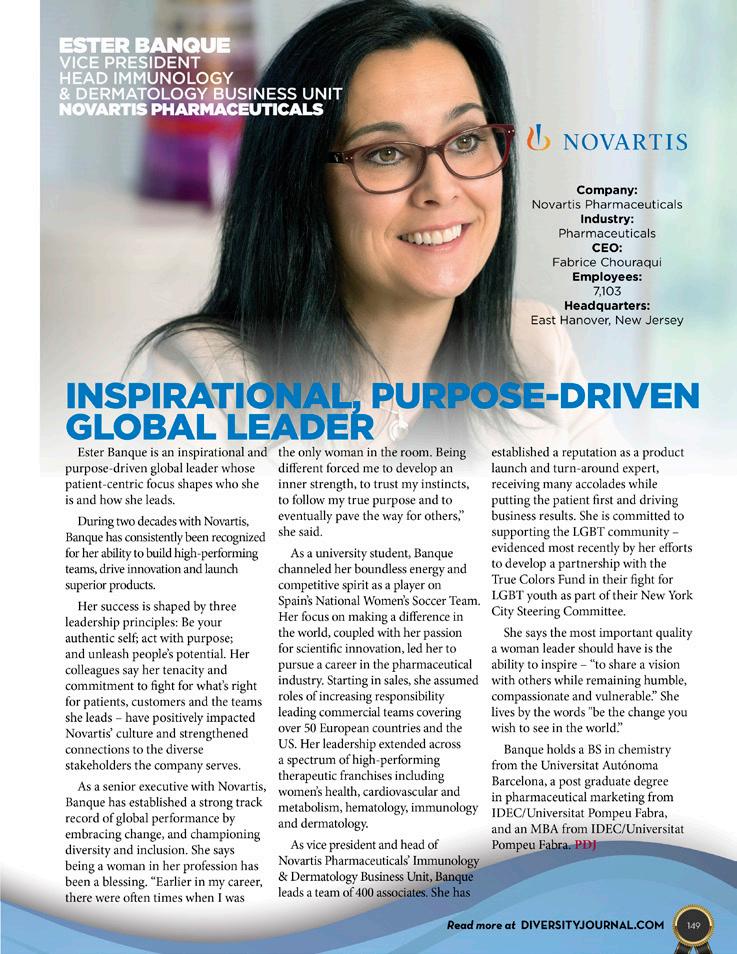
Senior Vice President & Head Intercontinental Commercial, Bristol-Myers Squibb
Since being named a Woman Worth Watching in 2016, Ester Banque has joined Bristol-Myers Squibb as a senior vice president and head intercontinental commercial.
Before joining her present company, Banque held executive-level leadership roles at Novartis, including general manager–Novartis Oncology–Germany. She also served as senior brand manager at Pharmacia.
Banque holds a bachelor’s degree in organic chemistry from Universitat Autònomo de Barcelona and an MBA from Universitat Pompeu Fabra, where she has done postgraduate work in pharmaceutical marketing. She has also completed Harvard Business School’s Business Finance Executive Program, as well as INSEAD’s Marketing Excellence Program.



Where are they now...
Kelli Parsons, a 2016 Woman Worth Watching, recently joined Hill+Knowlton Strategies as its global chair of corporate affairs.
Parsons previously served as senior vice president and chief communications officer for United Technologies, and has held senior-level positions with New York Life, Fannie Mae, Warburg Pincus, and Hill & Knowlton.
Parsons earned her master’s degree in journalism at Northwestern University and her bachelor’s degree in journalism and political science at Murray State University.





















Profiles in Diversity Journal invites you to participate in our Diversity Team Award, in which we will recognize the talented and dedicated team whose work is supporting and advancing diversity and inclusion in your organization and across the globe.
Nominating your Diversity Team affords you an important opportunity to showcase the contributions the team makes to your organization, and to celebrate the inclusivity that diverse individuals working together as members of a team represents.
Throughout its history, Profiles in Diversity Journal has recognized thousands of individuals from around the world who are making a difference. The Diversity Team profiles that will appear in the summer edition of our publication will recognize and celebrate the idea of teamwork, the importance of individual contributions, and the unique people in your organization who have come together to advance the cause of diversity and inclusion every day.


















